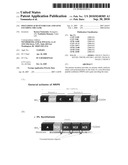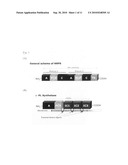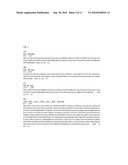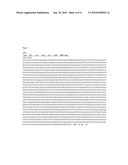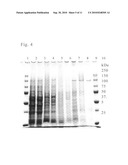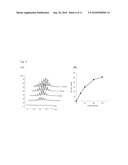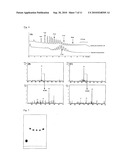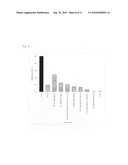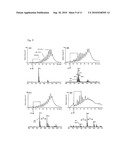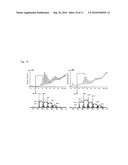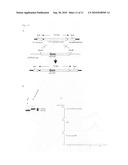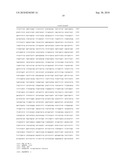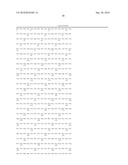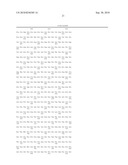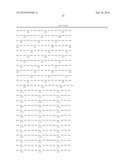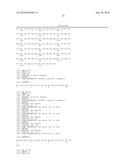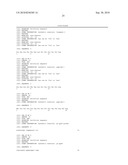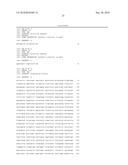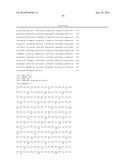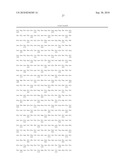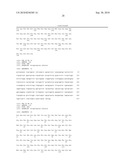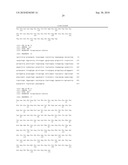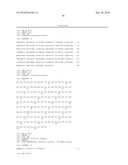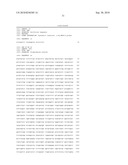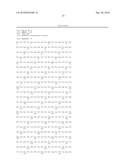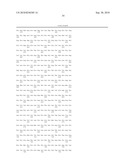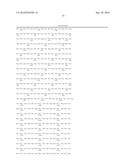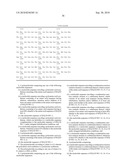Patent application title: POLYAMINO ACID SYNTHETASE AND GENE ENCODING THE SAME
Inventors:
Kazuya Yamanaka (Kanagawa, JP)
Yoshimitu Hamano (Fukui, JP)
IPC8 Class: AC12P2100FI
USPC Class:
435 691
Class name: Chemistry: molecular biology and microbiology micro-organism, tissue cell culture or enzyme using process to synthesize a desired chemical compound or composition recombinant dna technique included in method of making a protein or polypeptide
Publication date: 2010-09-30
Patent application number: 20100248305
Claims:
1. A polynucleotide comprising any one of the following nucleotide
sequences:(i) a nucleotide sequence encoding a polyamino acid synthetase
consisting of the amino acid sequence of SEQ ID NO: 2;(ii) a nucleotide
sequence encoding a polyamino acid synthetase consisting of an amino acid
sequence having deletion, substitution, insertion and/or addition of at
least one amino acid residue in the amino acid sequence of SEQ ID NO:
2;(iii) a nucleotide sequence encoding a polyamino acid synthetase
consisting of an amino acid sequence having at least 60% identity to the
amino acid sequence of SEQ ID NO: 2;(iv) the nucleotide sequence of SEQ
ID NO: 1;(v) a nucleotide sequence encoding a polyamino acid synthetase,
which can hybridize to a nucleotide sequence complementary to the
nucleotide sequence of SEQ ID NO: 1 under stringent hybridization
conditions; and(vi) a nucleotide sequence encoding a polyamino acid
synthetase, which has at least 65% identity to the nucleotide sequence of
SEQ ID NO: 1.
2. A polynucleotide comprising:(i) a nucleotide sequence encoding a polyamino acid synthetase consisting of the amino acid sequence of SEQ ID NO: 2; or(ii) the nucleotide sequence of SEQ ID NO: 1.
3. The polynucleotide according to claim 1 or 2, wherein the polyamino acid synthetase is a polylysine synthetase.
4. The polynucleotide according to any one of claims 1 to 3, which is a DNA or RNA.
5. A polynucleotide comprising any one of the following nucleotide sequences:(i) a nucleotide sequence encoding a condensation reaction catalytic domain or a subdomain thereof, which consists of the amino acid sequence of SEQ ID NO: 13, 15, 17 or 19;(ii) a nucleotide sequence encoding a condensation reaction catalytic domain or a subdomain thereof, which consists of an amino acid sequence having deletion, substitution, insertion and/or addition of at least one amino acid residue in the amino acid sequence of SEQ ID NO: 13, 15, 17 or 19;(iii) a nucleotide sequence encoding a condensation reaction catalytic domain or a subdomain thereof, which consists of an amino acid sequence having at least 60% identity to the amino acid sequence of SEQ ID NO: 13, 15, 17 or 19;(iv) the nucleotide sequence of SEQ ID NO: 12, 14, 16 or 18;(v) a nucleotide sequence encoding a condensation reaction catalytic domain or a subdomain thereof, which can hybridize to a nucleotide sequence complementary to the nucleotide sequence of SEQ ID NO: 12, 14, 16 or 18 under stringent hybridization conditions; and(vi) a nucleotide sequence encoding a condensation reaction catalytic domain or a subdomain thereof, which has at least 65% identity to the nucleotide sequence of SEQ ID NO: 12, 14, 16 or 18.
6. A polynucleotide comprising:(i) a nucleotide sequence encoding a condensation reaction catalytic domain or a subdomain thereof, which consists of the amino acid sequence of SEQ ID NO: 13, 15, 17 or 19; or(ii) the nucleotide sequence of SEQ ID NO: 12, 14, 16 or 18.
7. The polynucleotide according to claim 5 or 6, which is a DNA or RNA.
8. A polyamino acid synthetase comprising any one of the following amino acid sequences:(i) the amino acid sequence of SEQ ID NO: 2;(ii) an amino acid sequence having deletion, substitution, insertion and/or addition of at least one amino acid residue in the amino acid sequence of SEQ ID NO: 2; and(iii) an amino acid sequence having at least 60% identity to the amino acid sequence of SEQ ID NO: 2.
9. The polyamino acid synthetase according to claim 8, which is a polylysine synthetase.
10. A condensation reaction catalytic domain comprising any one of the following amino acid sequences:(i) the amino acid sequence of SEQ ID NO: 13, 15, 17 or 19;(ii) an amino acid sequence having deletion, substitution, insertion and/or addition of at least one amino acid residue in the amino acid sequence of SEQ ID NO: 13, 15, 17 or 19; and(iii) an amino acid sequence having at least 60% identity to the amino acid sequence of SEQ. ID NO: 13, 15, 17 or 19.
11. A polyamino acid synthetase comprising the condensation reaction catalytic domain according to claim 10.
12. The polyamino acid synthetase according to claim 11, which is a polylysine synthetase.
13. A recombinant vector comprising any one of the following nucleotide sequences:(i) a nucleotide sequence encoding a polyamino acid synthetase consisting of the amino acid sequence of SEQ ID NO: 2;(ii) a nucleotide sequence encoding a polyamino acid synthetase consisting of an amino acid sequence having deletion, substitution, insertion and/or addition of at least one amino acid residue in the amino acid sequence of SEQ ID NO: 2;(iii) a nucleotide sequence encoding a polyamino acid synthetase consisting of an amino acid sequence having at least 60% identity to the amino acid sequence of SEQ ID NO: 2;(iv) the nucleotide sequence of SEQ ID NO: 1;(v) a nucleotide sequence encoding a polyamino acid synthetase, which can hybridize to a nucleotide sequence complementary to the nucleotide sequence of SEQ ID NO: 1 under stringent hybridization conditions; and(vi) a nucleotide sequence encoding a polyamino acid synthetase, which has at least 65% identity to the nucleotide sequence of SEQ ID NO: 1.
14. A recombinant vector comprising:(i) a nucleotide sequence encoding a polyamino acid synthetase consisting of the amino acid sequence of SEQ ID NO: 2; or(ii) the nucleotide sequence of SEQ ID NO: 1.
15. The recombinant vector according to claim 13 or 14, wherein the polyamino acid synthetase is a polylysine synthetase.
16. A recombinant vector comprising any one of the following nucleotide sequences:(i) a nucleotide sequence encoding a condensation reaction catalytic domain or a subdomain thereof, which consists of the amino acid sequence of SEQ ID NO: 13, 15, 17 or 19;(ii) a nucleotide sequence encoding a condensation reaction catalytic domain or a subdomain thereof, which consists of an amino acid sequence having deletion, substitution, insertion and/or addition of at least one amino acid residue in the amino acid sequence of SEQ ID NO: 13, 15, 17 or 19;(iii) a nucleotide sequence encoding a condensation reaction catalytic domain or a subdomain thereof, which consists of an amino acid sequence having at least 60% identity to the amino acid sequence of SEQ ID NO: 13, 15, 17 or 19;(iv) the nucleotide sequence of SEQ ID NO: 12, 14, 16 or 18;(v) a nucleotide sequence encoding a condensation reaction catalytic domain or a subdomain thereof, which can hybridize to a nucleotide sequence complementary to the nucleotide sequence of SEQ ID NO: 12, 14, 16 or 18 under stringent hybridization conditions; and(vi) a nucleotide sequence encoding a condensation reaction catalytic domain or a subdomain thereof, which has at least 65% identity to the nucleotide sequence of SEQ ID NO: 12, 14, 16 or 18.
17. A recombinant vector comprising:(i) a nucleotide sequence encoding a condensation reaction catalytic domain or a subdomain thereof, which consists of the amino acid sequence of SEQ ID NO: 13, 15, 17 or 19; or(ii) the nucleotide sequence of SEQ ID NO: 12, 14, 16 or 18.
18. A transformant comprising the recombinant vector according to claim 13, 15 or 16.
19. A transformant comprising the recombinant vector according to claim 14 or 17.
20. A method for producing a polyamino acid synthetase using the recombinant vector according to claim 13, 15 or 16 or the transformant according to claim 18.
21. A method for producing a polyamino acid synthetase using the recombinant vector according to claim 14 or 17 or the transformant according to claim 19.
22. A method for producing a polyamino acid comprising the step of synthesizing the polyamino acid using a polyamino acid synthetase comprising any one of the following amino acid sequences:(i) the amino acid sequence of SEQ ID NO: 2;(ii) an amino acid sequence having deletion, substitution, insertion and/or addition of at least one amino acid residue in the amino acid sequence of SEQ ID NO: 2; and(iii) an amino acid sequence having at least 60% identity to the amino acid sequence of SEQ ID NO: 2.
23. A method for producing a polyamino acid comprising the step of synthesizing the polyamino acid using a polyamino acid synthetase comprising any one of the following amino acid sequences:(i) the amino acid sequence of SEQ ID NO: 13, 15, 17 or 19;(ii) an amino acid sequence having deletion, substitution, insertion and/or addition of at least one amino acid residue in the amino acid sequence of SEQ ID NO: 13, 15, 17 or 19; and(iii) an amino acid sequence having at least 60% identity to the amino acid sequence of SEQ ID NO: 13, 15, 17 or 19.
24. The method according to claim 22 or 23, wherein the polyamino acid is polylysine.
25. The method according to claim 24, wherein the polylysine is ε-poly-L-lysine.
26. A primer consisting of a polynucleotide comprising at least 15 contiguous nucleotides in any one of the following nucleotide sequences or complementary sequences thereof:(i) a nucleotide sequence encoding a polyamino acid synthetase consisting of the amino acid sequence of SEQ ID NO: 2 or a complementary sequence thereof;(ii) a nucleotide sequence encoding a polyamino acid synthetase consisting of an amino acid sequence having deletion, substitution, insertion and/or addition of at least one amino acid residue in the amino acid sequence of SEQ ID NO: 2 or a complementary sequence thereof;(iii) a nucleotide sequence encoding a polyamino acid synthetase consisting of an amino acid sequence having at least 60% identity to the amino acid sequence of SEQ ID NO: 2 or a complementary sequence thereof;(iv) the nucleotide sequence of SEQ ID NO: 1 or a complementary sequence thereof;(v) a nucleotide sequence encoding a polyamino acid synthetase, which can hybridize to a nucleotide sequence complementary to the nucleotide sequence of SEQ ID NO: 1 under stringent hybridization conditions, or a complementary sequence thereof; and(vi) a nucleotide sequence encoding a polyamino acid synthetase, which has at least 65% identity to the nucleotide sequence of SEQ ID NO: 1, or a complementary sequence thereof.
27. A primer consisting of a polynucleotide comprising at least 15 contiguous nucleotides in any one of the following nucleotide sequences or complementary sequences thereof:(i) a nucleotide sequence encoding a condensation reaction catalytic domain or a subdomain thereof, which consists of the amino acid sequence of SEQ ID NO: 13, 15, 17 or 19, or a complementary sequence thereof;(ii) a nucleotide sequence encoding a condensation reaction catalytic domain or a subdomain thereof, which consists of an amino acid sequence having deletion, substitution, insertion and/or addition of at least one amino acid residue in the amino acid sequence of SEQ ID NO: 13, 15, 17 or 19, or a complementary sequence thereof;(iii) a nucleotide sequence encoding a condensation reaction catalytic domain or a subdomain thereof, which consists of an amino acid sequence having at least 60% identity to the amino acid sequence of SEQ ID NO: 13, 15, 17 or 19, or a complementary sequence thereof;(iv) the nucleotide sequence of SEQ ID NO: 12, 14, 16 or 18 or a complementary sequence thereof;(v) a nucleotide sequence encoding a condensation reaction catalytic domain or a subdomain thereof, which can hybridize to a nucleotide sequence complementary to the nucleotide sequence of SEQ ID NO: 12, 14, 16 or 18 under stringent hybridization conditions, or a complementary sequence thereof; and(vi) a nucleotide sequence encoding a condensation reaction catalytic domain or a subdomain thereof, which has at least 65% identity to the nucleotide sequence of SEQ ID NO: 12, 14, 16 or 18, or a complementary sequence thereof.
28. A primer consisting of a polynucleotide comprising at least 15 contiguous nucleotides in any one of the following nucleotide sequences or complementary sequences thereof:(i) a nucleotide sequence encoding a polyamino acid synthetase consisting of the amino acid sequence of SEQ ID NO: 2 or a complementary sequence thereof;(ii) the nucleotide sequence of SEQ ID NO: 1 or a complementary sequence thereof;(iii) a nucleotide sequence encoding a condensation reaction catalytic domain or a subdomain thereof, which consists of the amino acid sequence of SEQ ID NO: 13, 15, 17 or 19, or a complementary sequence thereof; and(iv) the nucleotide sequence of SEQ ID NO: 12, 14, 16 or 18 or a complementary sequence thereof.
29. A polynucleotide probe consisting of a nucleotide sequence of at least 15 nucleotides, which can hybridize, under stringent hybridization conditions, to any one of the following nucleotide sequences:(i) a nucleotide sequence encoding a polyamino acid synthetase consisting of the amino acid sequence of SEQ ID NO: 2 or a complementary sequence thereof;(ii) a nucleotide sequence encoding a polyamino acid synthetase consisting of an amino acid sequence having deletion, substitution, insertion and/or addition of at least one amino acid residue in the amino acid sequence of SEQ ID NO: 2 or a complementary sequence thereof;(iii) a nucleotide sequence encoding a polyamino acid synthetase consisting of an amino acid sequence having at least 60% identity to the amino acid sequence of SEQ ID NO: 2 or a complementary sequence thereof;(iv) the nucleotide sequence of SEQ ID NO: 1 or a complementary sequence thereof;(v) a nucleotide sequence encoding a polyamino acid synthetase, which can hybridize to a nucleotide sequence complementary to the nucleotide sequence of SEQ ID NO: 1 under stringent hybridization conditions, or a complementary sequence thereof; and(vi) a nucleotide sequence encoding a polyamino acid synthetase, which has at least 65% identity to the nucleotide sequence of SEQ ID NO: 1, or a complementary sequence thereof.
30. A polynucleotide probe consisting of a nucleotide sequence of at least 15 nucleotides, which can hybridize, under stringent hybridization conditions, to any one of the following nucleotide sequences:(i) a nucleotide sequence encoding a condensation reaction catalytic domain or a subdomain thereof, which consists of the amino acid sequence of SEQ ID NO: 13, 15, 17 or 19, or a complementary sequence thereof;(ii) a nucleotide sequence encoding a condensation reaction catalytic domain or a subdomain thereof, which consists of an amino acid sequence having deletion, substitution, insertion and/or addition of at least one amino acid residue in the amino acid sequence of SEQ ID NO: 13, 15, 17 or 19, or a complementary sequence thereof;(iii) a nucleotide sequence encoding a condensation reaction catalytic domain or a subdomain thereof, which consists of an amino acid sequence having at least 60% identity to the amino acid sequence of SEQ ID NO: 13, 15, 17 or 19, or a complementary sequence thereof;(iv) the nucleotide sequence of SEQ ID NO: 12, 14, 16 or 18 or a complementary sequence thereof;(v) a nucleotide sequence encoding a condensation reaction catalytic domain or a subdomain thereof, which can hybridize to a nucleotide sequence complementary to the nucleotide sequence of SEQ ID NO: 12, 14, 16 or 18 under stringent hybridization conditions, or a complementary sequence thereof; and(vi) a nucleotide sequence encoding a condensation reaction catalytic domain or a subdomain thereof, which has at least 65% identity to the nucleotide sequence of SEQ ID NO: 12, 14, 16 or 18, or a complementary sequence thereof.
31. A polynucleotide probe consisting of a nucleotide sequence of at least 15 nucleotides, which can hybridize, under stringent hybridization conditions, to any one of the following nucleotide sequences:(i) a nucleotide sequence encoding a polyamino acid synthetase consisting of the amino acid sequence of SEQ ID NO: 2 or a complementary sequence thereof;(ii) the nucleotide sequence of SEQ ID NO: 1 or a complementary sequence thereof;(iii) a nucleotide sequence encoding a condensation reaction catalytic domain or a subdomain thereof, which consists of the amino acid sequence of SEQ ID NO: 13, 15, 17 or 19, or a complementary sequence thereof; and(iv) the nucleotide sequence of SEQ ID NO: 12, 14, 16 or 18 or a complementary sequence thereof.
32. An antibody which specifically binds to a polyamino acid synthetase comprising any one of the following amino acid sequences:(i) the amino acid sequence of SEQ ID NO: 2;(ii) an amino acid sequence having deletion, substitution, insertion and/or addition of at least one amino acid residue in the amino acid sequence of SEQ ID NO: 2; and(iii) an amino acid sequence having at least 60% identity to the amino acid sequence of SEQ ID NO: 2.
33. An antibody which specifically binds to: a condensation reaction catalytic domain or a subdomain thereof, which comprises any one of the following amino acid sequences:(i) the amino acid sequence of SEQ ID NO: 13, 15, 17 or 19;(ii) an amino acid sequence having deletion, substitution, insertion and/or addition of at least one amino acid residue in the amino acid sequence of SEQ ID NO: 13, 15, 17 or 19; and(iii) an amino acid sequence having at least 60% identity to the amino acid sequence of SEQ ID NO: 13, 15, 17 or 19; or a polyamino acid synthetase comprising the domain.
34. A method for screening a polynucleotide encoding a polyamino acid synthetase using the primer according to any one of claims 26 to 28.
35. The method according to claim 34, further using the probe according to any one of claims 29 to 31.
36. A method for screening a polyamino acid synthetase using the antibody according to claim 32 or 33.
Description:
TECHNICAL FIELD
[0001]The present invention relates to a novel polyamino acid synthetase and a gene encoding the same.
BACKGROUND ART
[0002]As methods for synthesizing a polyamino acid, conventional methods using chemical synthesis, enzymatic synthesis or the like are known.
[0003]Recently, various bioactive peptides realizing high degree of social contribution have been found. Examples of methods for synthesizing such peptides include the chemical synthesis method and the enzymatic synthesis method. Using the latter method, peptides can be produced without any harmful chemicals, and problems of environmental burden, etc. can be overcome. In addition, cost reduction can also be expected.
[0004]As one of methods for enzymatically synthesizing a polyamino acid, a method for enzymatically synthesizing a nonprotein amino acid polymer consisting of an aspartic acid backbone and arginine side chains, cyanophycin (multi-L-arginyl-poly(L-aspartic acid)) is known (Non-patent documents 1 and 2). A method for enzymatically synthesizing poly-γ-glutamic acid has also been reported (Non-patent document 3).
[0005]However, since enzymatic synthesis of these polyamino acids is accomplished by the catalyst action of a multiple-enzyme system, it is difficult to control, and therefore it has not been applied to industrial production. Further, except for the cases of the enzymatic synthesis of cyanophycin and poly-γ-glutamic acid, there is no example of a peptide having a long chain (equal to or longer than a tripeptide) or amino acid homopolymer successfully synthesized enzymatically.
[0006]Regarding biosynthesis of an antibacterial polyamino acid ε-poly-L-lysine, biosynthesis using the microbial fermentation method has been reported (Non-patent document 4).
[Non-patent document 1] Eur. J. Biochem. 267, 5561-5570 (2000)[Non-patent document 2] APPL. ENVIRON. MICROBIOL. Vol. 67, No. 5, May 2001, pp. 2176-2182[Non-patent document 3] APPL. ENVIRON. MICROBIOL. Vol. 70, No. 7, July 2004, pp. 4249-4255[Non-patent document 4] Agric. Biol. Chem. Vol. 45, 1981, pp. 2497-2502
DISCLOSURE OF THE INVENTION
Problems to be Solved by the Invention
[0007]Under the above-described circumstances, a method for efficiently producing any amino acid peptide with a longer chain or amino acid analog homopolymer is desired.
Means for Solving the Problems
[0008]The present inventors diligently made researches in order to meet the requirement and found a non-ribosomal peptide synthetase (NRPS) which catalyzes polymerization of L-lysine.
[0009]Accordingly, the present invention provides: a polyamino acid synthetase; a polynucleotide encoding the same; a vector comprising the polynucleotide; a method for producing the polyamino acid synthetase; a method for producing a polyamino acid using the polyamino acid synthetase; a primer comprising a partial sequence of the polynucleotide; a probe which can hybridize to the polynucleotide or a complementary sequence thereof; an antibody to the enzyme; a method for screening a polyamino acid synthetase using the primer or probe or antibody; and the like, as described below.
(1) A polynucleotide comprising any one of the following nucleotide sequences:(i) a nucleotide sequence encoding a polyamino acid synthetase consisting of the amino acid sequence of SEQ ID NO: 2;(ii) a nucleotide sequence encoding a polyamino acid synthetase consisting of an amino acid sequence having deletion, substitution, insertion and/or addition of at least one amino acid residue in the amino acid sequence of SEQ ID NO: 2;(iii) a nucleotide sequence encoding a polyamino acid synthetase consisting of an amino acid sequence having at least 60% identity to the amino acid sequence of SEQ ID NO: 2;(iv) the nucleotide sequence of SEQ ID NO: 1;(v) a nucleotide sequence encoding a polyamino acid synthetase, which can hybridize to a nucleotide sequence complementary to the nucleotide sequence of SEQ ID NO: 1 under stringent hybridization conditions; and(vi) a nucleotide sequence encoding a polyamino acid synthetase, which has at least 65% identity to the nucleotide sequence of SEQ ID NO: 1.(1a) A polynucleotide comprising any one of the following nucleotide sequences:(i) a nucleotide sequence encoding a polyamino acid synthetase consisting of an amino acid sequence having deletion, substitution, insertion and/or addition of one or several amino acid residues in the amino acid sequence of SEQ ID NO: 2;(ii) a nucleotide sequence encoding a polyamino acid synthetase consisting of an amino acid sequence having at least 80% identity to the amino acid sequence of SEQ ID NO: 2; and(iii) a nucleotide sequence encoding a polyamino acid synthetase, which can hybridize to a nucleotide sequence complementary to the nucleotide sequence of SEQ ID NO: 1 under highly stringent hybridization conditions.(2) A polynucleotide comprising:(i) a nucleotide sequence encoding a polyamino acid synthetase consisting of the amino acid sequence of SEQ ID NO: 2; or(ii) the nucleotide sequence of SEQ ID NO: 1.(3) The polynucleotide according to item (1) or (2), wherein the polyamino acid synthetase is a polylysine synthetase.(4) The polynucleotide according to any one of items (1) to (3), which is a DNA or RNA.(5) A polynucleotide comprising any one of the following nucleotide sequences:(i) a nucleotide sequence encoding a condensation reaction catalytic domain or a subdomain thereof, which consists of the amino acid sequence of SEQ ID NO: 13, 15, 17 or 19;(ii) a nucleotide sequence encoding a condensation reaction catalytic domain or a subdomain thereof, which consists of an amino acid sequence having deletion, substitution, insertion and/or addition of at least one amino acid residue in the amino acid sequence of SEQ ID NO: 13, 15, 17 or 19;(iii) a nucleotide sequence encoding a condensation reaction catalytic domain or a subdomain thereof, which consists of an amino acid sequence having at least 60% identity to the amino acid sequence of SEQ ID NO: 13, 15, 17 or 19;(iv) the nucleotide sequence of SEQ ID NO: 12, 14, 16 or 18;(v) a nucleotide sequence encoding a condensation reaction catalytic domain or a subdomain thereof, which can hybridize to a nucleotide sequence complementary to the nucleotide sequence of SEQ ID NO: 12, 14, 16 or 18 under stringent hybridization conditions; and(vi) a nucleotide sequence encoding a condensation reaction catalytic domain or a subdomain thereof, which has at least 65% identity to the nucleotide sequence of SEQ ID NO: 12, 14, 16 or 18.(5a) A polynucleotide comprising any one of the following nucleotide sequences:(i) a nucleotide sequence encoding a polyamino acid synthetase consisting of an amino acid sequence having deletion, substitution, insertion and/or addition of one or several amino acid residues in the amino acid sequence of SEQ ID NO: 13, 15, 17 or 19;(ii) a nucleotide sequence encoding a polyamino acid synthetase consisting of an amino acid sequence having at least 80% identity to the amino acid sequence of SEQ ID NO: 13, 15, 17 or 19; and(iii) a nucleotide sequence encoding a polyamino acid synthetase, which can hybridize to a nucleotide sequence complementary to the nucleotide sequence of SEQ ID NO: 12, 14, 16 or 18 under highly stringent hybridization conditions.(6) A polynucleotide comprising:(i) a nucleotide sequence encoding a condensation reaction catalytic domain or a subdomain thereof, which consists of the amino acid sequence of SEQ ID NO: 13, 15, 17 or 19; or(ii) the nucleotide sequence of SEQ ID NO: 12, 14, 16 or 18.(7) The polynucleotide according to item (5) or (6), which is a DNA or RNA.(8) A polyamino acid synthetase comprising any one of the following amino acid sequences:(i) the amino acid sequence of SEQ ID NO: 2;(ii) an amino acid sequence having deletion, substitution, insertion and/or addition of at least one amino acid residue in the amino acid sequence of SEQ ID NO: 2; and(iii) an amino acid sequence having at least 60% identity to the amino acid sequence of SEQ ID NO: 2.(8a) A polyamino acid synthetase comprising:(i) the amino acid sequence of SEQ ID NO: 2 having deletion, substitution, insertion and/or addition of one or several amino acid residues in the amino acid sequence of SEQ ID NO: 2; or(ii) an amino acid sequence having at least 80% identity to the amino acid sequence of SEQ ID NO: 2.(9) The polyamino acid synthetase according to item (8), which is a polylysine synthetase.(10) A condensation reaction catalytic domain comprising any one of the following amino acid sequences:(i) the amino acid sequence of SEQ ID NO: 13, 15, 17 or 19;(ii) an amino acid sequence having deletion, substitution, insertion and/or addition of at least one amino acid residue in the amino acid sequence of SEQ ID NO: 13, 15, 17 or 19; and(iii) an amino acid sequence having at least 60% identity to the amino acid sequence of SEQ ID NO: 13, 15, 17 or 19.(10a) A condensation reaction catalytic domain comprising:(i) an amino acid sequence having deletion, substitution, insertion and/or addition of one or several amino acid residues in the amino acid sequence of SEQ ID NO: 13, 15, 17 or 19; or(ii) an amino acid sequence having at least 80% identity to the amino acid sequence of SEQ ID NO: 13, 15, 17 or 19.(11) A polyamino acid synthetase comprising the condensation reaction catalytic domain according to item (10).(12) The polyamino acid synthetase according to item (11), which is a polylysine synthetase.(13) A recombinant vector comprising any one of the following nucleotide sequences:(i) a nucleotide sequence encoding a polyamino acid synthetase consisting of the amino acid sequence of SEQ ID NO: 2;(ii) a nucleotide sequence encoding a polyamino acid synthetase consisting of an amino acid sequence having deletion, substitution, insertion and/or addition of at least one amino acid residue in the amino acid sequence of SEQ ID NO: 2;(iii) a nucleotide sequence encoding a polyamino acid synthetase consisting of an amino acid sequence having at least 60% identity to the amino acid sequence of SEQ ID NO: 2;(iv) the nucleotide sequence of SEQ ID NO: 1;(v) a nucleotide sequence encoding a polyamino acid synthetase, which can hybridize to a nucleotide sequence complementary to the nucleotide sequence of SEQ ID NO: 1 under stringent hybridization conditions; and(vi) a nucleotide sequence encoding a polyamino acid synthetase, which has at least 65% identity to the nucleotide sequence of SEQ ID NO: 1.(13a) A recombinant vector comprising any one of the following nucleotide sequences:(i) a nucleotide sequence encoding a polyamino acid synthetase consisting of an amino acid sequence having deletion, substitution, insertion and/or addition of one or several amino acid residues in the amino acid sequence of SEQ ID NO: 2;(ii) a nucleotide sequence encoding a polyamino acid synthetase consisting of an amino acid sequence having at least 80% identity to the amino acid sequence of SEQ ID NO: 2; and(iii) a nucleotide sequence encoding a polyamino acid synthetase, which can hybridize to a nucleotide sequence complementary to the nucleotide sequence of SEQ ID NO: 1 under highly stringent hybridization conditions.(14) A recombinant vector comprising:(i) a nucleotide sequence encoding a polyamino acid synthetase consisting of the amino acid sequence of SEQ ID NO: 2; or(ii) the nucleotide sequence of SEQ ID NO: 1.(15) The recombinant vector according to item (13) or (14), wherein the polyamino acid synthetase is a polylysine synthetase.(16) A recombinant vector comprising any one of the following nucleotide sequences:(i) a nucleotide sequence encoding a condensation reaction catalytic domain or a subdomain thereof, which consists of the amino acid sequence of SEQ ID NO: 13, 15, 17 or 19;(ii) a nucleotide sequence encoding a condensation reaction catalytic domain or a subdomain thereof, which consists of an amino acid sequence having deletion, substitution, insertion and/or addition of at least one amino acid residue in the amino acid sequence of SEQ ID NO: 13, 15, 17 or 19;(iii) a nucleotide sequence encoding a condensation reaction catalytic domain or a subdomain thereof, which consists of an amino acid sequence having at least 60% identity to the amino acid sequence of SEQ ID NO: 13, 15, 17 or 19;(iv) the nucleotide sequence of SEQ ID NO: 12, 14, 16 or 18;(v) a nucleotide sequence encoding a condensation reaction catalytic domain or a subdomain thereof, which can hybridize to a nucleotide sequence complementary to the nucleotide sequence of SEQ ID NO: 12, 14, 16 or 18 under stringent hybridization conditions; and(vi) a nucleotide sequence encoding a condensation reaction catalytic domain or a subdomain thereof, which has at least 65% identity to the nucleotide sequence of SEQ ID NO: 12, 14, 16 or 18.(16a) A recombinant vector comprising any one of the following nucleotide sequences:(i) a nucleotide sequence encoding a polyamino acid synthetase consisting of an amino acid sequence having deletion, substitution, insertion and/or addition of one or several amino acid residues in the amino acid sequence of SEQ ID NO: 13, 15, 17 or 19;(ii) a nucleotide sequence encoding a polyamino acid synthetase consisting of an amino acid sequence having at least 80% identity to the amino acid sequence of SEQ ID NO: 13, 15, 17 or 19; and(iii) a nucleotide sequence encoding a polyamino acid synthetase, which can hybridize to a nucleotide sequence complementary to the nucleotide sequence of SEQ ID NO: 12, 14, 16 or 18 under highly stringent hybridization conditions.(17) A recombinant vector comprising:(i) a nucleotide sequence encoding a condensation reaction catalytic domain or a subdomain thereof, which consists of the amino acid sequence of SEQ ID NO: 13, 15, 17 or 19; or(ii) the nucleotide sequence of SEQ ID NO: 12, 14, 16 or 18.(18) A transformant comprising the recombinant vector according to item (13), (15) or (16).(19) A transformant comprising the recombinant vector according to item (14) or (17).(20) A method for producing a polyamino acid synthetase using the recombinant vector according to item (13), (15) or (16) or the transformant according to item (18).(21) A method for producing a polyamino acid synthetase using the recombinant vector according to item (14) or (17) or the transformant according to item (19).(22) A method for producing a polyamino acid comprising the step of synthesizing the polyamino acid using a polyamino acid synthetase comprising any one of the following amino acid sequences:(i) the amino acid sequence of SEQ ID NO: 2;(ii) an amino acid sequence having deletion, substitution, insertion and/or addition of at least one amino acid residue in the amino acid sequence of SEQ ID NO: 2; and(iii) an amino acid sequence having at least 60% identity to the amino acid sequence of SEQ ID NO: 2.(22a) A method for producing a polyamino acid comprising the step of synthesizing the polyamino acid using a polyamino acid synthetase comprising:(i) an amino acid sequence having deletion, substitution, insertion and/or addition of one or several amino acid residues in the amino acid sequence of SEQ ID NO: 2; or(ii) an amino acid sequence having at least 80% identity to the amino acid sequence of SEQ ID NO: 2.(23) A method for producing a polyamino acid comprising the step of synthesizing the polyamino acid using a polyamino acid synthetase comprising any one of the following amino acid sequences:(i) the amino acid sequence of SEQ ID NO: 13, 15, 17 or 19;(ii) an amino acid sequence having deletion, substitution, insertion and/or addition of at least one amino acid residue in the amino acid sequence of SEQ ID NO: 13, 15, 17 or 19; and(iii) an amino acid sequence having at least 60% identity to the amino acid sequence of SEQ ID NO: 13, 15, 17 or 19.(23a) A method for producing a polyamino acid comprising the step of synthesizing the polyamino acid using a polyamino acid synthetase comprising:(i) an amino acid sequence having deletion, substitution, insertion and/or addition of one or several amino acid residues in the amino acid sequence of SEQ ID NO: 13, 15, 17 or 19; or(ii) an amino acid sequence having at least 80% identity to the amino acid sequence of SEQ ID NO: 13, 15, 17 or 19.(24) The method according to item (22) or (23), wherein the polyamino acid is polylysine.(25) The method according to item (24), wherein the polylysine is ε-poly-L-lysine.(26) A primer consisting of a polynucleotide comprising at least 15 contiguous nucleotides in any one of the following nucleotide sequences or complementary sequences thereof:(i) a nucleotide sequence encoding a polyamino acid synthetase consisting of the amino acid sequence of SEQ ID NO: 2 or a complementary sequence thereof;(ii) a nucleotide sequence encoding a polyamino acid synthetase consisting of an amino acid sequence represented having deletion, substitution, insertion and/or addition of at least one amino acid residue in the amino acid sequence of SEQ ID NO: 2 or a complementary sequence thereof;(iii) a nucleotide sequence encoding a polyamino acid synthetase consisting of an amino acid sequence having at least 60% identity to the amino acid sequence of SEQ ID NO: 2 or a complementary sequence thereof;(iv) the nucleotide sequence of SEQ ID NO: 1 or a complementary sequence thereof;(v) a nucleotide sequence encoding a polyamino acid synthetase, which can hybridize to a nucleotide sequence complementary to the nucleotide sequence of SEQ ID NO: 1 under stringent hybridization conditions, or a complementary sequence thereof; and(vi) a nucleotide sequence encoding a polyamino acid synthetase, which has at least 65% identity to the nucleotide sequence of SEQ ID NO: 1, or a complementary sequence thereof.(26a) A primer consisting of a polynucleotide comprising at least 15 contiguous nucleotides in any one of the following nucleotide sequences or complementary sequences thereof:(i) a nucleotide sequence encoding a polyamino acid synthetase consisting of the amino acid sequence represented having deletion, substitution, insertion and/or addition of one or several amino acid residues in the amino acid sequence of SEQ ID NO: 2 or a complementary sequence thereof;(ii) a nucleotide sequence encoding a polyamino acid synthetase consisting of an amino acid sequence having at least 80% identity to the amino acid sequence of SEQ ID NO: 2 or a complementary sequence thereof; and(iii) a nucleotide sequence encoding a polyamino acid synthetase, which can hybridize to a nucleotide sequence complementary to the nucleotide sequence of SEQ ID NO: 1 under highly stringent hybridization conditions, or a complementary sequence thereof.(27) A primer consisting of a polynucleotide comprising at least 15 contiguous nucleotides in any one of the following nucleotide sequences or complementary sequences thereof:(i) a nucleotide sequence encoding a condensation reaction catalytic domain or a subdomain thereof, which consists of the amino acid sequence of SEQ ID NO: 13, 15, 17 or 19, or a complementary sequence thereof;(ii) a nucleotide sequence encoding a condensation reaction catalytic domain or a subdomain thereof, which consists of an amino acid sequence having deletion, substitution, insertion and/or addition of at least one amino acid residue in the amino acid sequence of SEQ ID NO: 13, 15, 17 or 19, or a complementary sequence thereof;(iii) a nucleotide sequence encoding a condensation reaction catalytic domain or a subdomain thereof, which consists of an amino acid sequence having at least 60% identity to the amino acid sequence of SEQ ID NO: 13, 15, 17 or 19, or a complementary sequence thereof;(iv) the nucleotide sequence of SEQ ID NO: 12, 14, 16 or 18 or a complementary sequence thereof;(v) a nucleotide sequence encoding a condensation reaction catalytic domain or a subdomain thereof, which can hybridize to a nucleotide sequence complementary to the nucleotide sequence of SEQ ID NO: 12, 14, 16 or 18 under stringent hybridization conditions, or a complementary sequence thereof; and(vi) a nucleotide sequence encoding a condensation reaction catalytic domain or a subdomain thereof, which has at least 65% identity to the nucleotide sequence of SEQ ID NO: 12, 14, 16 or 18, or a complementary sequence thereof.(27a) A primer consisting of a polynucleotide comprising at least 15 contiguous nucleotides in any one of the following nucleotide sequences or complementary sequences thereof:(i) a nucleotide sequence encoding a polyamino acid synthetase consisting of an amino acid sequence having deletion, substitution, insertion and/or addition of one or several amino acid residues in the amino acid sequence of SEQ ID NO: 13, 15, 17 or 19 or a complementary sequence thereof;(ii) a nucleotide sequence encoding a polyamino acid synthetase consisting of an amino acid sequence having at least 80%
identity to the amino acid sequence of SEQ ID NO: 13, 15, 17 or 19 or a complementary sequence thereof; and(iii) a nucleotide sequence encoding a polyamino acid synthetase, which can hybridize to a nucleotide sequence complementary to the nucleotide sequence of SEQ ID NO: 12, 14, 16 or 18 under highly stringent hybridization conditions, or a complementary sequence thereof.(28) A primer consisting of a polynucleotide comprising at least 15 contiguous nucleotides in any one of the following nucleotide sequences or complementary sequences thereof:(i) a nucleotide sequence encoding a polyamino acid synthetase consisting of the amino acid sequence of SEQ ID NO: 2 or a complementary sequence thereof;(ii) the nucleotide sequence of SEQ ID NO: 1 or a complementary sequence thereof;(iii) a nucleotide sequence encoding a condensation reaction catalytic domain or a subdomain thereof, which consists of the amino acid sequence of SEQ ID NO: 13, 15, 17 or 19, or a complementary sequence thereof; and(iv) the nucleotide sequence of SEQ ID NO: 12, 14, 16 or 18 or a complementary sequence thereof.(29) A polynucleotide probe consisting of a nucleotide sequence of at least 15 nucleotides, which can hybridize, under stringent hybridization conditions, to any one of the following nucleotide sequences:(i) a nucleotide sequence encoding a polyamino acid synthetase consisting of the amino acid sequence of SEQ ID NO: 2 or a complementary sequence thereof;(ii) a nucleotide sequence encoding a polyamino acid synthetase consisting of an amino acid sequence represented having deletion, substitution, insertion and/or addition of at least one amino acid residue in the amino acid sequence of SEQ ID NO: 2 or a complementary sequence thereof;(iii) a nucleotide sequence encoding a polyamino acid synthetase consisting of an amino acid sequence having at least 60% identity to the amino acid sequence of SEQ ID NO: 2 or a complementary sequence thereof;(iv) the nucleotide sequence of SEQ ID NO: 1 or a complementary sequence thereof;(v) a nucleotide sequence encoding a polyamino acid synthetase, which can hybridize to a nucleotide sequence complementary to the nucleotide sequence of SEQ ID NO: 1 under stringent hybridization conditions, or a complementary sequence thereof; and(vi) a nucleotide sequence encoding a polyamino acid synthetase, which has at least 65% identity to the nucleotide sequence of SEQ ID NO: 1, or a complementary sequence thereof.(29a) A polynucleotide probe consisting of a nucleotide sequence of at least 15 nucleotides, which can hybridize, under highly stringent hybridization conditions, to any one of the following nucleotide sequences:(i) a nucleotide sequence encoding a polyamino acid synthetase consisting of an amino acid sequence having deletion, substitution, insertion and/or addition of one or several amino acid residues in the amino acid sequence of SEQ ID NO: 2 or a complementary sequence thereof;(ii) a nucleotide sequence encoding a polyamino acid synthetase consisting of an amino acid sequence having at least 80% identity to the amino acid sequence of SEQ ID NO: 2 or a complementary sequence thereof; and(iii) a nucleotide sequence encoding a polyamino acid synthetase, which can hybridize to a nucleotide sequence complementary to the nucleotide sequence of SEQ ID NO: 1 under highly stringent hybridization conditions, or a complementary sequence thereof.(30) A polynucleotide probe consisting of a nucleotide sequence of at least 15 nucleotides, which can hybridize, under stringent hybridization conditions, to any one of the following nucleotide sequences:(i) a nucleotide sequence encoding a condensation reaction catalytic domain or a subdomain thereof, which consists of the amino acid sequence of SEQ ID NO: 13, 15, 17 or 19, or a complementary sequence thereof;(ii) a nucleotide sequence encoding a condensation reaction catalytic domain or a subdomain thereof, which consists of an amino acid sequence having deletion, substitution, insertion and/or addition of at least one amino acid residue in the amino acid sequence of SEQ ID NO: 13, 15, 17 or 19, or a complementary sequence thereof;(iii) a nucleotide sequence encoding a condensation reaction catalytic domain or a subdomain thereof, which consists of an amino acid sequence having at least 60% identity to the amino acid sequence of SEQ ID NO: 13, 15, 17 or 19, or a complementary sequence thereof;(iv) the nucleotide sequence of SEQ ID NO: 12, 14, 16 or 18 or a complementary sequence thereof;(v) a nucleotide sequence encoding a condensation reaction catalytic domain or a subdomain thereof, which can hybridize to a nucleotide sequence complementary to the nucleotide sequence of SEQ ID NO: 12, 14, 16 or 18 under stringent hybridization conditions, or a complementary sequence thereof; and(vi) a nucleotide sequence encoding a condensation reaction catalytic domain or a subdomain thereof, which has at least 65% identity to the nucleotide sequence of SEQ ID NO: 12, 14, 16 or 18, or a complementary sequence thereof.(30a) A polynucleotide probe consisting of a nucleotide sequence of at least 15 nucleotides, which can hybridize, under highly stringent hybridization conditions, to any one of the following nucleotide sequences:(i) a nucleotide sequence encoding a polyamino acid synthetase consisting of an amino acid sequence having deletion, substitution, insertion and/or addition of one or several amino acid residues in the amino acid sequence of SEQ ID NO: 13, 15, 17 or 19 or a complementary sequence thereof;(ii) a nucleotide sequence encoding a polyamino acid synthetase consisting of an amino acid sequence having at least 80% identity to the amino acid sequence of SEQ ID NO: 13, 15, 17 or 19 or a complementary sequence thereof; and(iii) a nucleotide sequence encoding a polyamino acid synthetase, which can hybridize to a nucleotide sequence complementary to the nucleotide sequence of SEQ ID NO: 12, 14, 16 or 18 under highly stringent hybridization conditions, or a complementary sequence thereof.(31) A polynucleotide probe consisting of a nucleotide sequence of at least 15 nucleotides, which can hybridize, under stringent hybridization conditions, to any one of the following nucleotide sequences:(i) a nucleotide sequence encoding a polyamino acid synthetase consisting of the amino acid sequence of SEQ ID NO: 2 or a complementary sequence thereof;(ii) the nucleotide sequence of SEQ ID NO: 1 or a complementary sequence thereof;(iii) a nucleotide sequence encoding a condensation reaction catalytic domain or a subdomain thereof, which consists of the amino acid sequence of SEQ ID NO: 13, 15, 17 or 19, or a complementary sequence thereof; and(iv) the nucleotide sequence of SEQ ID NO: 12, 14, 16 or 18 or a complementary sequence thereof.(32) An antibody which specifically binds to a polyamino acid synthetase comprising any one of the following amino acid sequences:(i) the amino acid sequence of SEQ ID NO: 2;(ii) an amino acid sequence having deletion, substitution, insertion and/or addition of at least one amino acid residue in the amino acid sequence of SEQ ID NO: 2; and(iii) an amino acid sequence having at least 60% identity to the amino acid sequence of SEQ ID NO: 2.(33) An antibody which specifically binds to: a condensation reaction catalytic domain or a subdomain thereof, which comprises any one of the following amino acid sequences:(i) the amino acid sequence of SEQ ID NO: 13, 15, 17 or 19;(ii) an amino acid sequence having deletion, substitution, insertion and/or addition of at least one amino acid residue in the amino acid sequence of SEQ ID NO: 13, 15, 17 or 19; and(iii) an amino acid sequence having at least 60% identity to the amino acid sequence of SEQ ID NO: 13, 15, 17 or 19; or a polyamino acid synthetase comprising the domain.(34) A method for screening a polynucleotide encoding a polyamino acid synthetase using the primer according to any one of items (26) to (28).(35) The method according to item (34), further using the probe according to any one of items (29) to (31).(36) A method for screening a polyamino acid synthetase using the antibody according to item (32) or (33).
ADVANTAGEOUS EFFECT OF THE INVENTION
[0010]According to the present invention, a polyamino acid (e.g., ε-poly-L-lysine) can be enzymatically synthesized. The enzymatic synthesis method can save more energy than the microbial fermentation method and the chemical synthesis method, and can suppress undesired side reactions. Therefore, the enzymatic synthesis method has the advantage that it is possible to produce a highly-pure polyamino acid. Since many peptides and polyamino acids produced by microorganisms including cyanophycin and poly-γ-glutamic acid are biosynthesized by the catalyst action of a multiple-enzyme system, it is difficult to carry out industrial production thereof enzymatically. However, since the polyamino acid synthetase of the present invention is a single thiotemplate type non-ribosomal peptide synthetase (NRPS), it also has the advantage that it can be easily controlled and is suitable for enzymatic industrial production.
[0011]Thus, the present invention can provide a method for producing a polyamino acid more efficiently than conventional methods. Moreover, when using the polynucleotide-containing recombinant vector and the transformant of the present invention, it is possible to apply the present invention to biosynthesis of various useful polyamino acids.
BRIEF DESCRIPTION OF THE DRAWINGS
[0012]FIG. 1A is a diagram showing the multi-module structure of the conventional NRPS. FIG. 1B is a diagram showing the single-module structure of a polyamino acid synthetase in one embodiment of the present invention.
[0013]FIG. 2 A-D show the amino acid sequences of the condensation reaction catalytic domain and subdomains thereof positioned at the C-terminal side of the polyamino acid synthetase of the present invention. In the figures, "tmr" means a transmembrane region.
[0014]FIG. 3 A-C show the DNA sequences of the subdomains of the condensation reaction catalytic domain positioned at the C-terminal side of the polyamino acid synthetase of the present invention.
[0015]FIG. 3D shows the DNA sequence of the condensation reaction catalytic domain positioned at the C-terminal side of the polyamino acid synthetase of the present invention. In the figure, "tmr" means a transmembrane region.
[0016]FIG. 4 is a photograph showing the results of SDS-PAGE analysis of respective fractions in the purification process of the ε-poly-L-lysine biosynthetic enzyme of the present invention. Lanes 1 and 11: molecular-weight marker (recombinant protein, Bio-Rad), Lane 2: crude enzyme solution, Lane 3: soluble fraction, Lane 4: cell membrane fraction, Lane 5: salt-soluble fraction, Lane 6: salt-washed cell membrane fraction, Lane 7: NP-40-soluble fraction, Lane 8: eluted fraction from DEAE TOYOPEARL column, Lane 9: eluted fraction from AF-Blue TOYOPEARL column, Lane 10: eluted fraction from Sephacryl S-300 column.
[0017]FIG. 5A is a graph showing the results of HPLC analysis of ε-poly-L-lysine in enzymatic reaction solution. FIG. 5B is a graph showing the concentration of ε-poly-L-lysine in reaction solution obtained by making a calibration curve using the ε-poly-L-lysine standard product and making calculation based on the results in FIG. 5A.
[0018]FIG. 6A is a graph showing separation pattern of liquid chromatography (LC). FIG. 6B is a graph showing the result of mass analysis of 14 mer of a product obtained by hydrolyzing the ε-poly-L-lysine standard product with hydrochloric acid. FIG. 6C is a graph showing the result of mass analysis of 14 mer of enzymatically-synthesized ε-poly-L-lysine.
[0019]FIG. 7 is a graph showing the analysis results of thin-layer chromatography of a product obtained by hydrolyzing a DNP-lated ε-poly-L-lysine with hydrochloric acid. Lane 1: L-lysine, Lane 2: a product produced by hydrolyzing a DNP-lated α-poly-L-lysine (Wako Pure Chemical Industries, Ltd.) with hydrochloric acid, Lane 3: a product produced by hydrolyzing a DNP-lated ε-poly-L-lysine standard product (Chisso corporation) with hydrochloric acid, Lane 4: a product produced by hydrolyzing a DNP-lated enzymatically-synthesized ε-poly-L-lysine with hydrochloric acid, Lane 5: N.sup.α-2,4-DNP-L-lysine, Lane 6: N.sup.ε-2,4-DNP-L-lysine.
[0020]FIG. 8 is a graph showing substrate specificity of the amino acid synthetase of the present invention in an amino acid activation (adenylation) reaction. Relative activity is shown with the activity to L-lysine being regarded as 100%. None of L-Ala, L-Val, L-Leu, L-Ile, L-Phe, L-Pro, L-Trp, L-Met, Gly, L-Ser, L-Thr, L-Cys, L-Gln, L-Asn, L-Tyr, L-Arg, L-His, L-Asp and L-Glu was adenylated.
[0021]FIG. 9 shows the results of ESI-LC-MS analysis of polyamino acids produced by an enzymatic reaction using a mixture of L-lysine and analog as a substrate. (A) is a graph showing the fraction pattern in LC and the result of mass analysis of a polyamino acid obtained by a reaction using only L-lysine as a substrate (ε-poly-L-lysine). (B) is a graph showing the fraction pattern in LC and the result of mass analysis of a polyamino acid obtained by a reaction using a mixture of 1.8 mM O-(2-aminoethyl)-L-serine and 0.2 mM L-lysine as a substrate. (C) is a graph showing the fraction pattern in LC and the result of mass analysis of a polyamino acid obtained by a reaction using a mixture of 1.8 mM S-(2-aminoethyl)-L-cysteine and 0.2 mM L-lysine as a substrate. (D) is a graph showing the fraction pattern in LC and the result of mass analysis of a polyamino acid obtained by a reaction using a mixture of 1.6 mM DL-5-hydroxylysine and 0.4 mM L-lysine as a substrate.
[0022]FIG. 10 shows the results of ESI-LC-MS analysis of polyamino acids produced by a reaction of bacterium. (A) is a graph showing the fraction pattern in LC and the result of mass analysis of a polyamino acid obtained from a reaction solution of bacterium containing 1.6 mM L-lysine. (B) is a graph showing the fraction pattern in LC and the result of mass analysis of a polyamino acid obtained from a reaction solution of bacterium containing 0.4 mM L-lysine.
[0023]FIG. 11 shows a method for disrupting the ε-poly-L-lysine biosynthetic enzyme gene and influence thereof. (A) schematically shows a procedure for preparing a gene-disrupted strain using a plasmid for disruption, pLAEnrps-apr. (B) shows that disruption of the ε-poly-L-lysine biosynthetic enzyme gene was confirmed by genomic Southern hybridization. (C) shows the results of confirmation of the productivity of ε-poly-L-lysine using HPLC after culturing a disrupted strain obtained in a production medium.
BEST MODE FOR CARRYING OUT THE INVENTION
[0024]The present inventors isolated and purified a membrane-bound ε-poly-L-lysine biosynthetic enzyme from a ε-poly-L-lysine producing bacterium, Streptomyces albulus strain IFO14147, and determined the amino acid sequence thereof (SEQ ID NO: 2) and the nucleotide sequence (SEQ ID NO: 1) of the gene encoding the amino acid sequence. When the amino acid sequence and the DNA sequence of the ε-poly-L-lysine biosynthetic enzyme of the present invention were subjected to homology search using the NCBI sequence database, the following results were obtained: regarding the amino acid sequence, the highest identity was 54.1% (77.3% similarity); regarding the DNA sequence, the highest identity was 64.2%; and regarding a local region (region of important domain (positions 470 to 795)), a sequence having at least 80% identity was found.
[0025]According to one embodiment of the present invention, a polylysine biosynthetic enzyme and a gene encoding the same are provided. The enzyme of the present invention is the only membrane enzyme as NRPS which had not been known. Therefore, according to another embodiment of the present invention, a membrane-bound NRPS is provided.
[0026]Many peptides produced by microorganisms having physiological activity, which can be applied to pharmaceutical agents, have been found. Many of these peptides are biosynthesized by the catalyst action of a multi-module conjugate enzyme, which is called "non-ribosomal peptide synthetase (NRPS)".
[0027]A NRPS is constituted by a module as a base unit, which consists of: an adenylation domain (A-domain) which catalyzes activation of amino acids; a domain called peptidyl carrier domain or thiolation domain (PCP-Domain) which bonds an amino acid or peptide intermedite molecule; a condensation domain (C-Domain) which catalyzes condensation of a substrate; and a thioesterase domain (TE-Domain) which is involved in circularization of a peptide and isolation of a peptide from a NRPS that are final steps of biosynthesis (FIG. 1). To a thiolation domain, a 4'-phosphopantetheine (P-pant) arm, which is a cofactor for bonding an amino acid or intermediate, binds (not shown). There is a case where a domain which is involved in modification of peptide such as epimerization and methylation is further added to the module.
[0028]Each of the domains of NRPS has a plurality of regions which are commonly conserved in peptide synthetases. For example, a microcystin biosynthesis gene is cloned using, as a probe, a fragment obtained by PCR amplification based on the nucleotide sequence information of such regions.
[0029]When the polylysine biosynthetic enzyme of the present invention was analyzed using an analysis tool which performs function prediction based on structure comparison with a protein having a similar domain structure in a database such as CDD (Conserved Domain Database: http://www.ncbi.nlm.nih.gov/Structure/cdd/cdd.shtml/), it was confirmed that A-Domain and PCP-Domain bonding a peptide intermediate molecule were present at the N-terminus like many other NRPSs. However, it was revealed that a region of about 700 amino acid residues at the C-terminal side is a novel (unknown) domain, which does not have homology to conventional C-Domain or TE-Domain. Further, conventional NRPSs are multi-module conjugate enzymes, but it was strongly suggested that the enzyme of the present invention is a single-module single enzyme based on the domain structure analysis and the result of enzyme purification. Thus, in the case of the enzyme of the present invention, polyamino acid synthesis is accomplished only using the single module, and therefore, it is thought that the novel domain consisting of 700 amino acid residues at the C-terminal side catalyzes a "repeated condensation reaction". Accordingly, in one embodiment of the present invention, a polylysine biosynthetic enzyme comprising the above-described region of about 700 amino acid residues at the C-terminal side is provided.
[0030]Moreover, conventional NRPSs are localized in cytoplasm (soluble fraction), but the present enzyme is the only membrane enzyme which had not been known as NRPS, and it was thought that the membrane-bound (transmembrane) region is present in the novel domain at the C-terminus. Therefore, the C-terminal novel domain of the enzyme of the present invention was analyzed in further detail using an analysis tool which performs prediction of the secondary structure of a membrane protein or the like based on an amino acid sequence. According to SOSUI (http://bp.nuap.nagoya-u.acjp/sosui/), as predicted, 6 regions which are assumed to be transmembrane regions were confirmed in the C-terminal novel domain, and the possibility that the novel domain which is thought to catalyze the "repeated condensation reaction" is constituted by 3 subdomains, IC1, IC2 and IC3-Domains was suggested (FIG. 1B and FIG. 2). Therefore, in another embodiment of the present invention, a polylysine biosynthetic enzyme comprising any one of the above-described 3 subdomains is provided.
[0031]Hereinafter, the present invention will be described in detail.
1. Polyamino Acid Synthetase of the Present Invention and Polynucleotide Encoding the Same
[0032]The present invention provides a polyamino acid synthetase and a gene encoding the same. Specifically, the present invention provides a polyamino acid synthetase comprising any one of the following amino acid sequences: (i) the amino acid sequence of SEQ ID NO: 2; (ii) an amino acid sequence having deletion, substitution, insertion and/or addition of at least one amino acid residue in the amino acid sequence of SEQ ID NO: 2; and (iii) an amino acid sequence having at least 60% identity to the amino acid sequence of SEQ ID NO: 2.
[0033]The present invention also provides a polynucleotide comprising a nucleotide sequence encoding a polyamino acid synthetase consisting of any one of the following amino acid sequences: (i) the amino acid sequence of SEQ ID NO: 2; (ii) an amino acid sequence having deletion, substitution, insertion and/or addition of at least one amino acid residue in the amino acid sequence of SEQ ID NO: 2; and (iii) an amino acid sequence having at least 60% identity to the amino acid sequence of SEQ ID NO: 2.
[0034]The present invention also provides a polynucleotide comprising any one of the following nucleotide sequences: (i) the nucleotide sequence of SEQ ID NO: 1; (ii) a nucleotide sequence encoding a polyamino acid synthetase, which can hybridize to a nucleotide sequence complementary to the nucleotide sequence of SEQ ID NO: 1 under stringent hybridization conditions; and (iii) a nucleotide sequence encoding a polyamino acid synthetase, which has at least 65% identity to the nucleotide sequence of SEQ ID NO: 1.
[0035]In a preferred embodiment of the present invention, the above-described polyamino acid synthetase is a polylysine synthetase, and more preferably a ε-poly-L-lysine synthetase. The above-described polynucleotide may be a DNA or RNA, and preferably DNA.
[0036]In the present specification, the "polyamino acid synthetase of the present invention" includes not only (i) a polyamino acid synthetase consisting of the amino acid sequence of SEQ ID NO: 2, but also a polyamino acid synthetase consisting of an amino acid sequence having high homology to the amino acid sequence of SEQ ID NO: 2, e.g., (ii) a polyamino acid synthetase consisting of an amino acid sequence having deletion, substitution, insertion and/or addition of at least one amino acid residue in the amino acid sequence of SEQ ID NO: 2, and (iii) a polyamino acid synthetase consisting of an amino acid sequence having high identity (e.g., at least about 60%) to the amino acid sequence of SEQ ID NO: 2. Further, the enzyme activity of the polyamino acid synthetase can be measured and/or confirmed using, for example, the method of Kawai et al. (Biochem Biophys Res Commun. 2003 Nov. 21; 311(3): 635-40).
[0037]Examples of the "polyamino acid synthetase consisting of an amino acid sequence having deletion, substitution, insertion and/or addition of at least one amino acid residue in the amino acid sequence of SEQ ID NO: 2" include polyamino acid synthetases consisting of an amino acid sequence having deletion, substitution, insertion and/or addition of, for example, 1 to 50, 1 to 40, 1 to 39, 1 to 38, 1 to 37, 1 to 36, 1 to 35, 1 to 34, 1 to 33, 1 to 32, 1 to 31, 1 to 30, 1 to 29, 1 to 28, 1 to 27, 1 to 26, 1 to 25, 1 to 24, 1 to 23, 1 to 22, 1 to 21, 1 to 20, 1 to 19, 1 to 18, 1 to 17, 1 to 16, 1 to 15, 1 to 14, 1 to 13, 1 to 12, 1 to 11, 1 to 10, 1 to 9, 1 to 8, 1 to 7, 1 to 6 (1 to several), 1 to 5, 1 to 4, 1 to 3, 1 to 2, or 1 amino acid residue in the amino acid sequence of SEQ ID NO: 2. In general, the number of the above-described amino acid residues to be deleted, substituted, inserted and/or added is preferably smaller.
[0038]Examples of the "polyamino acid synthetase consisting of an amino acid sequence having high identity to the amino acid sequence of SEQ ID NO: 2" include polyamino acid synthetases consisting of an amino acid sequence having at least about 60%, at least 65%, at least 70%, at least 75%, at least 80%, at least 81%, at least 82%, at least 83%, at least 84%, at least 85%, at least 86%, at least 87%, at least 88%, at least 89%, at least 90%, at least 91%, at least 92%, at least 93%, at least 94%, at least 95%, at least 96%, at least 97%, at least 98%, at least 99%, at least 99.1%, at least 99.2%, at least 99.3%, at least 99.4%, at least 99.5%, at least 99.6%, at least 99.7%, at least 99.8%, or at least 99.9% identity to the amino acid sequence of SEQ ID NO: 2. In general, the bigger the numerical value of the above-described identity, the more preferable it is. In the present specification, the term "identity" is distinguished from the term "homology". For example, when referring to the homology between amino acid sequences, amino acids having similar properties (e.g., glutamic acid and aspartic acid) are regarded as belonging to the same group, but when referring to the identity, such amino acids are distinguished from each other. That is, identity means consistency.
[0039]In the present specification, when describing that a nucleotide sequence "hybridizes", it means that a double strand is formed in the case in which complementation between nucleotide sequences is high. Usually, a double strand is designed so that nucleic acids thereof are complementary to each other. However, one or several (e.g., 2 to 3) nucleic acid mismatches may be included as necessary (as long as there is no problem in view of its purpose when using the nucleic acid for detection, for example). The number of mismatches which may exist may vary depending on, for example, required accuracy of detection and the length of a nucleotide sequence (or base sequence or nucleic acid (sequence) or polynucleotide). Note that those skilled in the art know well that the case where a mismatch exists can be eliminated and the number of mismatches acceptable can be adjusted by suitably changing the conditions for the hybridization of a nucleotide sequence to another nucleotide sequence to which the nucleotide sequence hybridizes.
[0040]Examples of hybridization methods which can be employed include the colony hybridization method, plaque hybridization method and Southern hybridization method (for example, see Molecular Cloning 3rd Ed., Current Protocols in Molecular Biology, John Wiley & Sons 1987-1997).
[0041]In the present specification, the "stringent hybridization conditions" may be any of low stringent conditions, moderately stringent conditions and highly stringent conditions. The "low stringent conditions" are, for example: 5×SSC; 5×Denhart solution; 0.5% (w/v) SDS; 50% (w/v) formamide; and 32° C. The "moderately stringent conditions" are, for example: 5×SSC; 5×Denhart solution; 0.5% (w/v) SDS; 50% (w/v) formamide; and 42° C. The "highly stringent conditions" are, for example: 5×SSC; 5×Denhart solution; 0.5% (w/v) SDS; 50% (w/v) formamide; and 50° C. Under these conditions, it is expected that a DNA having high identity can be efficiently obtained at a higher temperature. However, it is thought that hybridization stringency is affected by a plurality of factors such as temperature, nucleic acid concentration, nucleic acid length, ion strength, time, and salt concentration. Those skilled in the art would be able to realize similar stringency by suitably selecting these elements.
[0042]When using a commercially available kit for hybridization, for example, Alkphos Direct Labelling Reagents (manufactured by Amersham Pharmacia) can be used. In this case, according to a protocol attached to the kit, incubation with a labeled probe is performed overnight, and thereafter a membrane is washed with a primary wash buffer containing 0.1% (w/v) SDS at 55° C., thereby detecting a polynucleotide which hybridizes.
[0043]Examples of the "nucleotide sequence which can hybridize, under stringent hybridization conditions," to a desired nucleotide sequence (e.g., the nucleotide sequence of SEQ ID NO: 1) include nucleotide sequences having at least about 60%, at least 65%, at least 70%, at least 75%, at least 80%, at least 81%, at least 82%, at least 83%, at least 84%, at least 85%, at least 86%, at least 87%, at least 88%, at least 89%, at least 90%, at least 91%, at least 92%, at least 93%, at least 94%, at least 95%, at least 96%, at least 97%, at least 98%, at least 99%, at least 99.1%, at least 99.2%, at least 99.3%, at least 99.4%, at least 99.5%, at least 99.6%, at least 99.7%, at least 99.8%, or at least 99.9% identity to the desired nucleotide sequence when performing calculation by a homology (or identity) search software such as FASTA and BLAST using default parameters.
[0044]The identity of an amino acid sequence or nucleotide sequence can be determined using the BLAST algorithm of Karlin & Altschul (Proc. Natl. Acad. Sci. USA, 87, 2264-2268, 1990; and Proc. Natl. Acad. Sci. USA, 90, 5873, 1993). Programs called BLASTN and BLASTX based on the BLAST algorithm have been developed (Altschul S F, et al.: J Mol Biol 215: 403, 1990). When analyzing a nucleotide sequence using BLASTN, parameters are set, for example, as follows: score=100; and wordlength=12. When analyzing an amino acid sequence using BLASTX, parameters are set, for example, as follows: score=50; and wordlength=3. When using BLAST and Gapped BLAST program, default parameters of each of the programs can be used.
2. C-Terminal Domain of the Polyamino Acid Synthetase of the Present Invention and Polynucleotide Encoding the Same
[0045]In the case of conventional NRPSs, peptides or polyamino acids are polymerized by the catalyst action of a multi-module conjugate enzyme, but it is strongly suggested that the polyamino acid synthetase of the present invention is a single-module single enzyme based on the domain structure analysis and the result of enzyme purification (see FIGS. 1A and B). In the case of the polyamino acid synthetase of the present invention, since the polyamino acid synthesis is accomplished only using the single module, it is thought that the novel domain of the present invention consisting of about 700 amino acid residues at the C-terminal side catalyzes a "repeated condensation reaction". Further, when analysis was carried out using an analyzing tool for protein structure such as CDD, it was inferred that 3 subdomains exist at the above-described C-terminal domain and that 6 transmembrane regions exist at boundaries between the subdomains (see FIG. 1B).
[0046]Therefore, according to another embodiment of the present invention, a C-terminal domain comprising about 700 amino acid residues at the C-terminal side of the polyamino acid synthetase of the present invention (hereinafter referred to as a "condensation reaction catalytic domain"), a polyamino acid synthetase comprising the condensation reaction catalytic domain, and a polynucleotide comprising a nucleotide sequence encoding the domain or the enzyme are provided. When just describing "condensation reaction catalytic domain" in this specification, it means a condensation reaction catalytic domain of a polyamino acid synthetase.
[0047]The condensation reaction catalytic domain of the present invention is a functional domain consisting of a polypeptide comprising an amino acid sequence corresponding to a region generally spanning over positions 611 to 1319 of the amino acid sequence of the ε-poly-L-lysine synthetase of the present invention represented by SEQ ID NO: 2 (positions 1831 to 3957 of the nucleotide sequence), as typically shown in FIGS. 2A-2D and 3A-3D. The amino acid sequence thereof and the nucleotide sequence encoding the same are represented by SEQ ID NO: 13 and SEQ ID NO: 12, respectively. Further, 3 smaller domains (IC1, IC2 and IC3-Domains) constituting the domain typically correspond to a region of about positions 676 to 847, a region of about positions 914 to 1083, and a region of about positions 1147 to 1299 of the amino acid sequence of the ε-poly-L-lysine synthetase of the present invention represented by SEQ ID NO: 2, respectively (positions 2026 to 2541, positions 2740 to 3249 and positions 3439 to 3897 of the nucleotide sequence, respectively). The amino acid sequences of these 3 subdomains are represented by SEQ ID NO: 15, SEQ ID NO: 17 and SEQ ID NO: 19, respectively, and the nucleotide sequences encoding these amino acid sequences are represented by SEQ ID NO: 14, SEQ ID NO: 16 and SEQ ID NO: 18, respectively.
[0048]In this specification, the "condensation reaction catalytic domain of the present invention" includes not only (i) a condensation reaction catalytic domain consisting of the amino acid sequence of SEQ ID NO: 13, but also a condensation reaction catalytic domain consisting of an amino acid sequence having high homology to the amino acid sequence of SEQ ID NO: 13, e.g., (ii) a condensation reaction catalytic domain consisting of an amino acid sequence having deletion, substitution, insertion and/or addition of at least one amino acid residue in the amino acid sequence of SEQ ID NO: 13, and (iii) a condensation reaction catalytic domain consisting of an amino acid sequence having high identity (e.g., at least about 60%) to the amino acid sequence of SEQ ID NO: 13.
[0049]In this specification, the "subdomain of the present invention (condensation reaction catalytic domain)" includes not only (i) a subdomain (of the condensation reaction catalytic domain) consisting of the amino acid sequence of SEQ ID NO: 15, 17 or 19, but also a subdomain (of the condensation reaction catalytic domain) consisting of an amino acid sequence having high homology to the amino acid sequence of SEQ ID NO: 15, 17 or 19, e.g., (ii) a subdomain (of the condensation reaction catalytic domain) consisting of an amino acid sequence having deletion, substitution, insertion and/or addition of at least one amino acid residue in the amino acid sequence of SEQ ID NO: 15, 17 or 19, and (iii) a subdomain (of the condensation reaction catalytic domain) consisting of an amino acid sequence having high identity (e.g., at least about 60%) to the amino acid sequence of SEQ ID NO: 15, 17 or 19.
[0050]Therefore, the present invention also provides: a condensation reaction catalytic domain or a subdomain thereof which comprises any one of the following amino acid sequences: (i) the amino acid sequence of SEQ ID NO: 13, 15, 17 or 19; (ii) an amino acid sequence having deletion, substitution, insertion and/or addition of at least one amino acid residue in the amino acid sequence of SEQ ID NO: 13, 15, 17 or 19; and (iii) an amino acid sequence having at least 60% identity to the amino acid sequence of SEQ ID NO: 13, 15, 17 or 19; and a polyamino acid synthetase comprising the domain. It can be confirmed whether or not a condensation reaction has occurred, for example, by detecting a polymerized product (enzymatic reaction product) utilizing LC-MS/MS or the like.
[0051]The present invention also provides a polynucleotide comprising a nucleotide sequence encoding: a condensation reaction catalytic domain or a subdomain thereof, which consists of any one of the following amino acid sequences: (i) the amino acid sequence of SEQ ID NO: 13, 15, 17 or 19; (ii) an amino acid sequence having deletion, substitution, insertion and/or addition of at least one amino acid residue in the amino acid sequence of SEQ ID NO: 13, 15, 17 or 19; and (iii) an amino acid sequence having at least 60% identity to the amino acid sequence of SEQ ID NO: 13, 15, 17 or 19; ora polyamino acid synthetase comprising the domain.
[0052]The present invention also provides a polynucleotide comprising any one of the following nucleotide sequences: (i) the nucleotide sequence of SEQ ID NO: 12, 14, 16 or 18; (ii) a nucleotide sequence encoding a condensation reaction catalytic domain or a subdomain thereof, which can hybridize to a nucleotide sequence complementary to the nucleotide sequence of SEQ ID NO: 12, 14, 16 or 18 under stringent hybridization conditions; and (iii) a nucleotide sequence encoding a condensation reaction catalytic domain or a subdomain thereof, which has at least 65% identity to the nucleotide sequence of SEQ ID NO: 12, 14, 16 or 18.
[0053]Examples of the "condensation reaction catalytic domain or a subdomain thereof, which consists of an amino acid sequence having deletion, substitution, insertion and/or addition of at least one amino acid residue in the amino acid sequence of SEQ ID NO: 13, 15, 17 or 19, or a polyamino acid synthetase comprising the domain" include a condensation reaction catalytic domain or a subdomain thereof, which consists of an amino acid sequence having deletion, substitution, insertion and/or addition of, for example, 1 to 50, 1 to 40, 1 to 39, 1 to 38, 1 to 37, 1 to 36, 1 to 35, 1 to 34, 1 to 33, 1 to 32, 1 to 31, 1 to 30, 1 to 29, 1 to 28, 1 to 27, 1 to 26, 1 to 25, 1 to 24, 1 to 23, 1 to 22, 1 to 21, 1 to 20, 1 to 19, 1 to 18, 1 to 17, 1 to 16, 1 to 15, 1 to 14, 1 to 13, 1 to 12, 1 to 11, 1 to 10, 1 to 9, 1 to 8, 1 to 7, 1 to 6 (1 to several), 1 to 5, 1 to 4, 1 to 3, 1 to 2, or 1 amino acid residue in the amino acid sequence of SEQ ID NO: 13, 15, 17 or 19, and a polyamino acid synthetase comprising the domain. In general, the smaller the number of the above-described amino acid residues to be deleted, substituted, inserted and/or added, the more preferable it is.
[0054]Examples of the "condensation reaction catalytic domain or a subdomain thereof, which consists of an amino acid sequence having high identity to the amino acid sequence of SEQ ID NO: 13, 15, 17 or 19, or a polyamino acid synthetase comprising the domain" include a condensation reaction catalytic domain or a subdomain thereof, which consists of an amino acid sequence having at least about 60%, at least 65%, at least 70%, at least 75%, at least 80%, at least 81%, at least 82%, at least 83%, at least 84%, at least 85%, at least 86%, at least 87%, at least 88%, at least 89%, at least 90%, at least 91%, at least 92%, at least 93%, at least 94%, at least 95%, at least 96%, at least 97%, at least 98%, at least 99%, at least 99.1%, at least 99.2%, at least 99.3%, at least 99.4%, at least 99.5%, at least 99.6%, at least 99.7%, at least 99.8%, or at least 99.9% identity to the amino acid sequence of SEQ ID NO: 13, 15, 17 or 19, and a polyamino acid synthetase comprising the domain. In general, the larger the numerical value of the above-described identity, the more preferable it is. In the present specification, the term "identity" is distinguished from the term "homology". For example, when referring to the homology between amino acid sequences, amino acids having similar properties (e.g., glutamic acid and aspartic acid) are regarded as belonging to the same group, but when referring to the identity, such amino acids are distinguished from each other. That is, identity means consistency.
[0055]Examples of the "nucleotide sequence which can hybridize to the nucleotide sequence of SEQ ID NO: 12, 14, 16 or 18 under stringent hybridization conditions" include nucleotide sequences having at least about 60%, at least 65%, at least 70%, at least 75%, at least 80%, at least 81%, at least 82%, at least 83%, at least 84%, at least 85%, at least 86%, at least 87%, at least 88%, at least 89%, at least 90%, at least 91%, at least 92%, at least 93%, at least 94%, at least 95%, at least 96%, at least 97%, at least 98%, at least 99%, at least 99.1%, at least 99.2%, at least 99.3%, at least 99.4%, at least 99.5%, at least 99.6%, at least 99.7%, at least 99.8%, or at least 99.9% identity to the desired nucleotide sequence when performing calculation by a homology (or identity) search software such as FASTA and BLAST using default parameters.
3. Recombinant Vector, Transformant and Method for Producing Polyamino Acid Synthetase Using the Same of the Present Invention
[0056]The present invention also relates to a recombinant vector comprising a polynucleotide encoding the polyamino acid synthetase of the present invention as an insert. Specifically, the present invention provides a recombinant vector comprising a nucleotide sequence encoding a polyamino acid synthetase consisting of any one of the following amino acid sequences: (i) the amino acid sequence of SEQ ID NO: 2; (ii) an amino acid sequence having deletion, substitution, insertion and/or addition of at least one amino acid residue in the amino acid sequence of SEQ ID NO: 2; and (iii) an amino acid sequence having at least 60% identity to the amino acid sequence of SEQ ID NO: 2.
[0057]The present invention also provides a recombinant vector comprising a polynucleotide consisting of any one of the following nucleotide sequences: (i) the nucleotide sequence of SEQ ID NO: 1; (ii) a nucleotide sequence encoding a polyamino acid synthetase, which can hybridize to a nucleotide sequence complementary to the nucleotide sequence of SEQ ID NO: 1 under stringent hybridization conditions; and (iii) a nucleotide sequence encoding a polyamino acid synthetase, which has at least 65% identity to the nucleotide sequence of SEQ ID NO: 1.
[0058]The present invention also relates to a recombinant vector comprising a polynucleotide encoding the condensation reaction catalytic domain of the present invention or a subdomain thereof or a polynucleotide encoding a polyamino acid synthetase comprising the condensation reaction catalytic domain or a subdomain thereof as an insert. Specifically, the present invention provides a recombinant vector comprising a nucleotide sequence encoding: a polynucleotide encoding a condensation reaction catalytic domain or a subdomain thereof, which consists of any one of the following amino acid sequences: (i) the amino acid sequence of SEQ ID NO: 13, 15, 17 or 19; (ii) an amino acid sequence having deletion, substitution, insertion and/or addition of at least one amino acid residue in the amino acid sequence of SEQ ID NO: 13, 15, 17 or 19; and (iii) an amino acid sequence having at least 60% identity to the amino acid sequence of SEQ ID NO: 13, 15, 17 or 19; or a polyamino acid synthetase comprising the condensation reaction catalytic domain or a subdomain thereof.
[0059]The present invention further provides a recombinant vector comprising a polynucleotide consisting of any one of the following nucleotide sequences: (i) the nucleotide sequence of SEQ ID NO: 12, 14, 16 or 18; (ii) a nucleotide sequence encoding a condensation reaction catalytic domain or a subdomain thereof, which can hybridize to a nucleotide sequence complementary to the nucleotide sequence of SEQ ID NO: 12, 14, 16 or 18 under stringent hybridization conditions; and (iii) a nucleotide sequence encoding a condensation reaction catalytic domain or a subdomain thereof, which has at least 65% identity to the nucleotide sequence of SEQ ID NO: 12, 14, 16 or 18.
[0060]In a preferred embodiment of the present invention, the recombinant vector is a recombinant expression vector in which an insert thereof can be expressed. Such a recombinant vector can be prepared using any method known in the art.
[0061]In the present invention, a vector to be used for expressing the polyamino acid synthetase of the present invention may be a vector which is suitable for the cell-free expression system (in vitro transcription-translation) or the protein expression system using a host cell such as E. coli, yeast, cultured animal cell or the like. Such a vector is commercially available or can be easily prepared from a publicly-known vector. Examples of vectors to be used for in vitro translation and expression in a cultured animal cell include: a pTargetT vector, in which an immediate-early enhancer/promoter region of human cytomegalovirus is incorporated, and which has, at a downstream region thereof, a T7 promoter sequence/multicloning site; a pSI vector having SV40 enhancer and an early promoter of SV40 (Promega); pBK-CMV, CMV-Script, pCMV-Tag and pBK-RSV (STRATAGENE); and the like. Examples of vectors suitable for expression in a microbial host such as E. coli and yeast include: an expression vector system of the pET series having T7 promoter of E. coli (e.g., pET3a, pET27b (+) and pET28a (+) (Novagen)); and Pichia expression-based vectors of the pIC series having an alcohol oxidase promoter of yeast (e.g., pPIC9K and PIC3.5K (Invitorgen)).
[0062]A peptide sequence for purification may be a peptide sequence which is used in the art. Examples thereof include: a histidine tag sequence having at least 4, and preferably at least 6 contiguous histidine residues; an epitope tag sequence having the ability to bind to a monoclonal antibody; and a sequence encoding a glutathione binding domain or protein A of glutathione S-transtransferase. A vector containing a DNA encoding such a peptide sequence as an insert is commercially available. Examples of vectors to be used for a host of microorganisms such as E. coli and yeast include: an expression vector having a T7 promoter of E. coli, and fusion expressing 10 histidine residues at its amino terminus (e.g., pET16b; Novagen); an expression vector having 6 histidine residues at the amino terminus (e.g., pHB6; Roche Diagnostics, pTrc-His series of vectors; Invitrogen, and pHAT series of vectors; Clontech); and the like. As a vector to be used for expression in a cultured animal cell, a vector which fusion expresses 6 histidine residues at its amino terminus (e.g., pHM6 and pVM6; Roche Diagnostics) can be used. In the case of cultured insect cells, a vector which fusion expresses 6 histidine residues of baculovirus at its amino terminus (e.g., pBacPAK-His vector; Clontech), pGEX series of vectors which fusion express glutathione S-transferase (Pharmacia), and pRIT2 or pEZZ 18 vector expressing protein A (Pharmacia) can be used.
[0063]In vitro translation for producing the polyamino acid synthetase of the present invention can be performed using publicly-known methods, for example, those described in: Spirin, A. S., et. al., Science 242: 1162-1164 (1988); and Patnaik, R. & Swartz, J. M. Biotechniques 24: 862-868 (1998), and a commercially-available in vitro translation kit (e.g., TNT-in vitro transcription/translation kit, Promega) may be used.
[0064]The present invention also relates to a transformant transformed with the above-described recombinant vector (e.g., host cell (e.g., microorganisms (E. coli, yeast, etc.)) and cultured animal cell (cultured insect cell, cultured mammalian cell (e.g., CHO cell and COS7 cell))).
[0065]The present invention also relates to a method for producing a polyamino acid synthetase using the recombinant vector of the present invention or the transformant of the present invention. The method for producing the polyamino acid synthetase of the present invention consists of, for example, performing in vitro transcription/translation using the recombinant expression vector of the present invention. Alternatively, the method consists of culturing a host cell transformed with the above-described recombinant expression vector and isolating a desired protein.
[0066]In the method for producing the polyamino acid synthetase of the present invention, after culturing a host cell, a protein expressed can be isolated from a culture medium or a soluble or insoluble fraction of bacterium.
[0067]In the method for producing the polyamino acid synthetase of the present invention, a protein expressed is isolated and purified using a publicly-known method, but a purification method may be suitably selected from publicly-known methods. For example, when the polyamino acid synthetase of the present invention includes a peptide sequence for the above-described purification, the purification is preferably performed using this. Specifically, nickel chelate affinity chromatography may be used for a histidine tag sequence, affinity chromatography with glutathione binding gel may be used for a binding domain of glutathione of S-transtransferase, and antibody affinity chromatography may be used for protein A or other protein sequences.
4. Polyamino Acid Production Method of the Present Invention
[0068]The present invention also relates to a method for producing the polyamino acid of the present invention. Specifically, the present invention provides a method for producing a polyamino acid, which comprises the step of synthesizing the polyamino acid using a polyamino acid synthetase comprising any one of the following amino acid sequences:
(i) the amino acid sequence of SEQ ID NO: 2;(ii) an amino acid sequence having deletion, substitution, insertion and/or addition of at least one amino acid residue in the amino acid sequence of SEQ ID NO: 2; and(iii) an amino acid sequence having at least 60% identity to the amino acid sequence of SEQ ID NO: 2
[0069]The present invention also provides a method for producing a polyamino acid, which comprises the step of synthesizing the polyamino acid using a polyamino acid synthetase comprising any one of the following amino acid sequences:
(i) the amino acid sequence of SEQ ID NO: 13, 15, 17 or 19;(ii) an amino acid sequence having deletion, substitution, insertion and/or addition of at least one amino acid residue in the amino acid sequence of SEQ ID NO: 13, 15, 17 or 19; and(iii) an amino acid sequence having at least 60% identity to the amino acid sequence of SEQ ID NO: 13, 15, 17 or 19.
[0070]The above-described polyamino acid is preferably polylysine, and more preferably ε-poly-L-lysine.
[0071]The polyamino acid production method of the present invention is carried out by reacting amino acid in the presence of the above-described polyamino acid synthetase. Here, a typical example of amino acid to be reacted is L-lysine, but the present invention is not limited thereto. For example, L-lysine ethyl ester, L-lysine methyl ester (in both the cases, ε-poly-L-lysine is produced), etc. may also be used for polyamino acid synthesis using the amino acid synthetase of the present invention. Moreover, there is a possibility that D-lysine, DL-5-hydroxy-lysine, Nε-methyl-L-lysine, L-lysine-hydroxamic acid, S-(2-aminoethyl)-L-cysteine, O-(2-aminoethyl)-L-serine, DL-trans-2,6-diamino-4-hexanoic acid, etc. may also be used in the polyamino acid production method of the present invention.
[0072]In the polyamino acid synthesis method of the present invention, the optimum pH for the polymerization reaction of amino acid using the above-described enzyme is preferably about 7 to 9.
[0073]The blending amount of the polyamino acid synthetase of the present invention is not particularly limited. In order to obtain a polymerized product by means of reaction of 1 g of raw material amino acid for several hours (2 to 5 hours), in general, the blending amount of the polyamino acid synthetase of the present invention is usually about at least 10,000 units, preferably about 20,000 to 40,000 units, and more preferably about 30,000 units. The temperature of the above-described reaction is not particularly limited as long as it allows the action of the enzyme. For example, the reaction proceeds at a low temperature (e.g., at about 15° C.), but on the premise that the enzyme acts efficiently and stably, usually, it is desired that the temperature is about 20 to 40° C. The reaction time can be suitably determined depending on the concentration of amino acid to be used, the addition amount of enzyme, etc., but usually, the reaction time is suitably set to about 0.5 to 5 hours, and within 24 hours at the most.
[0074]The polyamino acid thus obtained typically has a polymerization degree of 3 to 100 mer and an average molecular weight of 403 to 21835. The polymerization degree is preferably 4 to 50 mer, and more preferably 4 to 20 mer. The average molecular weight is preferably 531 to 6427, and more preferably 531 to 2581.
[0075]The polyamino acid obtained by the present invention can be used as an antimicrobial agent or the like, and can be used for various applications such as toiletry products, cosmetics, feed additives, medicines, agricultural chemicals, food additives, and electronic materials.
5. Primer, Probe and Screening Method Using the Same of the Present Invention
[0076]A partial fragment of the polynucleotide (DNA) of the present invention can be used for screening a homolog of the polyamino acid synthetase of the present invention or a polynucleotide encoding the same, for example, by utilizing the fragment as a probe or PCR primer.
[0077]Therefore, the present invention also provides a primer consisting of a polynucleotide comprising at least 15 contiguous nucleotides in any one of the following nucleotide sequences or complementary sequences thereof:
(i) a nucleotide sequence encoding a polyamino acid synthetase consisting of the amino acid sequence of SEQ ID NO: 2 or a complementary sequence thereof;(ii) a nucleotide sequence encoding a polyamino acid synthetase consisting of an amino acid sequence having deletion, substitution, insertion and/or addition of at least one amino acid residue in the amino acid sequence of SEQ ID NO: 2 or a complementary sequence thereof;(iii) a nucleotide sequence encoding a polyamino acid synthetase consisting of an amino acid sequence having at least 60% identity to the amino acid sequence of SEQ ID NO: 2 or a complementary sequence thereof;(iv) the nucleotide sequence of SEQ ID NO: 1 or a complementary sequence thereof;(v) a nucleotide sequence encoding a polyamino acid synthetase, which can hybridize to a nucleotide sequence complementary to the nucleotide sequence of SEQ ID NO: 1 under stringent hybridization conditions, or a complementary sequence thereof; and(vi) a nucleotide sequence encoding a polyamino acid synthetase, which has at least 65% identity to the nucleotide sequence of SEQ ID NO: 1, or a complementary sequence thereof.
[0078]The present invention also provides a primer consisting of a polynucleotide comprising at least 15 contiguous nucleotides in any one of the following nucleotide sequences or complementary sequences thereof:
(i) a nucleotide sequence encoding a condensation reaction catalytic domain or a subdomain thereof, which consists of the amino acid sequence of SEQ ID NO: 13, 15, 17 or 19, or a complementary sequence thereof;(ii) a nucleotide sequence encoding a condensation reaction catalytic domain or a subdomain thereof, which consists of an amino acid sequence having deletion, substitution, insertion and/or addition of at least one amino acid residue in the amino acid sequence of SEQ ID NO: 13, 15, 17 or 19, or a complementary sequence thereof;(iii) a nucleotide sequence encoding a condensation reaction catalytic domain or a subdomain thereof, which consists of an amino acid sequence having at least 60% identity to the amino acid sequence of SEQ ID NO: 13, 15, 17 or 19, or a complementary sequence thereof;(iv) the nucleotide sequence of SEQ ID NO: 12, 14, 16 or 18 or a complementary sequence thereof;(v) a nucleotide sequence encoding a condensation reaction catalytic domain or a subdomain thereof, which can hybridize to a nucleotide sequence complementary to the nucleotide sequence of SEQ ID NO: 12, 14, 16 or 18 under stringent hybridization conditions, or a complementary sequence thereof; and(vi) a nucleotide sequence encoding a condensation reaction catalytic domain or a subdomain thereof, which has at least 65% identity to the nucleotide sequence of SEQ ID NO: 12, 14, 16 or 18, or a complementary sequence thereof.
[0079]The present invention also provides a polynucleotide probe consisting of a nucleotide sequence of at least 15 nucleotides, which can hybridize, under stringent hybridization conditions, to any one of the following nucleotide sequences:
(i) a nucleotide sequence encoding a polyamino acid synthetase consisting of the amino acid sequence of SEQ ID NO: 2 or a complementary sequence thereof;(ii) a nucleotide sequence encoding a polyamino acid synthetase consisting of an amino acid sequence having deletion, substitution, insertion and/or addition of at least one amino acid residue in the amino acid sequence of SEQ ID NO: 2 or a complementary sequence thereof;(iii) a nucleotide sequence encoding a polyamino acid synthetase consisting of an amino acid sequence having at least 60% identity to the amino acid sequence of SEQ ID NO: 2 or a complementary sequence thereof;(iv) the nucleotide sequence of SEQ ID NO: 1 or a complementary sequence thereof;(v) a nucleotide sequence encoding a polyamino acid synthetase, which can hybridize to a nucleotide sequence complementary to the nucleotide sequence of SEQ ID NO: 1 under stringent hybridization conditions, or a complementary sequence thereof; and(vi) a nucleotide sequence encoding a polyamino acid synthetase, which has at least 65% identity to the nucleotide sequence of SEQ ID NO: 1, or a complementary sequence thereof.
[0080]The present invention also provides a polynucleotide probe consisting of a nucleotide sequence of at least 15 nucleotides, which can hybridize, under stringent hybridization conditions, to any one of the following nucleotide sequences:
(i) a nucleotide sequence encoding a condensation reaction catalytic domain or a subdomain thereof, which consists of the amino acid sequence of SEQ ID NO: 13, 15, 17 or 19, or a complementary sequence thereof;(ii) a nucleotide sequence encoding a condensation reaction catalytic domain or a subdomain thereof, which consists of an amino acid sequence having deletion, substitution, insertion and/or addition of at least one amino acid residue in the amino acid sequence of SEQ ID NO: 13, 15, 17 or 19, or a complementary sequence thereof;(iii) a nucleotide sequence encoding a condensation reaction catalytic domain or a subdomain thereof, which consists of an amino acid sequence having at least 60% identity to the amino acid sequence of SEQ ID NO: 13, 15, 17 or 19, or a complementary sequence thereof;(iv) the nucleotide sequence of SEQ ID NO: 12, 14, 16 or 18 or a complementary sequence thereof;(v) a nucleotide sequence encoding a condensation reaction catalytic domain or a subdomain thereof, which can hybridize to a nucleotide sequence complementary to the nucleotide sequence of SEQ ID NO: 12, 14, 16 or 18 under stringent hybridization conditions, or a complementary sequence thereof; and(vi) a nucleotide sequence encoding a condensation reaction catalytic domain or a subdomain thereof, which has at least 65% identity to the nucleotide sequence of SEQ ID NO: 12, 14, 16 or 18, or a complementary sequence thereof.
[0081]The present invention also provides a method for screening a polynucleotide encoding a polyamino acid synthetase using the above-described primer. Preferably, in the screening method, the above-described probe is further used.
[0082]Specifically, the primer or probe of the present invention can be used, for example, for analysis of the presence of a homolog of the polyamino acid synthetase of the present invention in an analyte by means of Northern hybridization or semiquantitative reverse PCR (Sourvinos, G et al., Oncogene, 18, 4968, (1999)) using the above-described primer and/or probe, or for detection of the presence/absence of mutation of a gene encoding the polyamino acid synthetase of the present invention in an analyte or the position of mutation by means of the PCR-SSCP method (Proc. Natl. Acad. Sci. USA., 86, 2766, (1989)) or the like.
[0083]The length of the primer or probe is not particularly limited as long as it is enough for the above-described analysis or detection. However, usually, the nucleotide length of the primer is preferably about 10 to 100, more preferably about 15 to 80, even more preferably about 20 to 60, and most preferably about 20 to 40. The nucleotide length of the probe is, for example, about 10 to 1000, about 15 to 1500, preferably about 20 to 1000, more preferably about 30 to 800, even more preferably about 50 to 700, still more preferably about 100 to 500, and most preferably about 200 to 500.
[0084]An amplification method using the primer of the present invention may be polymerase chain reaction (PCR; Saiki et al., 1988), ligase chain reaction (LCR; Landgren et al., 1988; Wu & Wallace, 1989; Barany, 1991), nucleic acid sequence-based amplification (NASBA; Guatelli et al., 1990; Compton, 1991), a transcription-based amplification system (TAS; Kwoh et al., 1989), strand displacement amplification (SDA; Duck, 1990; Walker et al., 1992), amplification using QB replicase (Lizardi et al., 1988; Lomeli et al., 1989), or any of other appropriate methods for amplifying a nucleic acid molecule using primer extension. During amplification, an amplified product can be conveniently labeled using a labeled primer or by taking a labeled nucleotide. Labeling may be performed using any of isotopes (e.g., 32P and 35S) and nonisotopes (e.g., biotin and digoxigenin). Amplification reaction is repeated 20 to 70 times, and preferably 25 to 45 times.
6. Antibody of the Present Invention
[0085]The present invention also relates to an antibody, which is prepared using the polyamino acid synthetase of the present invention or a fragment thereof as an antigen, and which specifically binds to the antigen, e.g., a polyclonal antibody or a monoclonal antibody. Specifically, the present invention provides:
[0086]an antibody which specifically binds to a polyamino acid synthetase comprising any one of the following amino acid sequences:
(i) the amino acid sequence of SEQ ID NO: 2;(ii) an amino acid sequence having deletion, substitution, insertion and/or addition of at least one amino acid residue in the amino acid sequence of SEQ ID NO: 2; and(iii) an amino acid sequence having at least 60% identity to the amino acid sequence of SEQ ID NO: 2.
[0087]The present invention also provides an antibody which specifically binds to: a condensation reaction catalytic domain or a subdomain thereof which comprises any one of the following amino acid sequences:
(i) the amino acid sequence of SEQ ID NO: 13, 15, 17 or 19;(ii) an amino acid sequence having deletion, substitution, insertion and/or addition of at least one amino acid residue in the amino acid sequence of SEQ ID NO: 13, 15, 17 or 19; and(iii) an amino acid sequence having at least 60% identity to the amino acid sequence of SEQ ID NO: 13, 15, 17 or 19; or a polyamino acid synthetase comprising the domain.
[0088]The antibody which specifically binds to the polyamino acid synthetase of the present invention can be produced using the polyamino acid synthetase of the present invention as an antigen according to an antibody (or antiserum) production method known in the art. As an antigen, an extracted natural protein, a recombinant protein, a partial decomposition product of these proteins, or a synthetic peptide based on the amino acid sequence of the polyamino acid synthetase of the present invention can be used. Such an antigen is, for example, a polypeptide consisting of an amino acid sequence of at least 5 contiguous amino acids, and preferably 10 to 15 amino acid residues in the amino acid sequence of SEQ ID NO: 2. The antibody of the present invention can be prepared according to the ordinary method (e.g., Harlow, E. & Lane, D, in Antibodies-Laboratory manual Cold Spring Harbor LaboratoryPress., pp. 53-138 (1988)).
[0089]The antibody of the present invention can be used for detection and search of the polyamino acid synthetase of the present invention and other polyamino acid synthetases having sequence homology to the protein. According to the screening method of the present invention, a similar polyamino acid synthetase in terms of the classification can be easily obtained.
[0090]The above-described screening method consists of, for example, detecting and searching a protein to which the antibody of the present invention binds using a rough extract from another living organism or tissue thereof containing another polyamino acid synthetase as a sample. Examples of such means for detection include immunoblotting and immunoaffinity chromatography. Further, with respect to a DNA library of another living organism or tissue thereof containing another polyamino acid synthetase, expression cloning (Sambrook, J., Fritsch, E. F., & Maniatis, T., Molecular Cloning--a Laboratory Mannual, second edition. Cold Spring Harbor Laboratory Press. pp. 12.3-12.44 (1989)) is carried out using the antibody of the present invention, thereby directly obtaining a DNA encoding a novel polyamino acid synthetase.
[0091]Hereinafter, the present invention will be specifically described by way of illustrative examples, but the present invention is not limited thereto.
EXAMPLES
Example 1
Purification of ε-Poly-L-Lysine Biosynthetic Enzyme from Streptomyces Albulus Strain IFO14147 which Produces ε-Poly-L-Lysine and Examination of Enzymatic Properties Thereof
[0092](1) Culture of Streptomyces albulus Strain IFO14147, which is a ε-Poly-L-Lysine Producing Strain
[0093]Culture of the strain was performed in a M3G medium (5% glucose, 0.5% yeast extract, 1% ammonium sulfate, 0.08% K2HPO4, 0.136% KH2PO4, 0.05% MgSO4.7H2O, 0.004% ZnSO4.7H2O, 0.003% FeSO4.7H2O (pH 6.8)). 100 ml of preculture solution obtained by aerobically culturing at 30° C. for 20 hours was added to 2 L of medium, and using a 3 L jar fermenter (Marubishi Bioengineering), culturing was carried out aerobically at 30° C. at 500 rpm with the ventilation volume of 2.5 L/min. As the bacterium grew, pH of the culture solution gradually decreased. Therefore, from the time point at which pH reached 4.2 that is most suitable for ε-poly-L-lysine production, 10% aqueous ammonia was added to the culture solution, thereby maintaining pH of 4.2. After culture for 32 hours, the bacterium was collected from the culture solution by centrifugation. The yield was about 240 g wet weight.
(2) Purification of ε-Poly-L-Lysine Biosynthetic Enzyme from Streptomyces albulus Strain IFO14147 which Produces ε-Poly-L-Lysine
[0094]All the steps for purification were carried out at 4° C. or on the ice. 75 g wet weight of bacterium was suspended in buffer solution A (pH 8.0) consisting of 150 ml of 100 mM tris(hydroxymethyl)aminomethane, 20% (w/v) glycerol, 0.2 M NaCl, 2 mM EDTA and 5 mM DTT, and the bacterium was disintegrated by means of sonication. The treated solution was subjected to centrifugation at 10,000 g for 20 minutes to remove residues, thereby preparing a crude enzyme solution. This was subjected to ultracentrifugation (Beckman Coulter) at 160,000 g for 1 hour, and precipitate was collected as cell membrane fraction. The obtained cell membrane fraction was suspended in buffer solution B (pH 8.0) consisting of 30 ml of 100 mM tris(hydroxymethyl)aminomethane, 20 (w/v) % glycerol, 1.0 M NaCl and 5 mM DTT, and this was subjected to sonication. After that, collection was carried out by ultracentrifugation in the same way to obtain salt-washed cell membrane fraction. The salt-washed cell membrane fraction was suspended in buffer solution C (pH 8.6) consisting of 30 ml of 100 mM tris(hydroxymethyl)aminomethane, 30% (w/v) glycerol, 1% (w/v) NP-40 (IGEPAL CA-630, MP-Biomedicals) and 5 mM DTT, and sonication and ultracentrifugation were carried out in the same way. The obtained supernatant was NP-40 solubilized cell membrane fraction containing ε-poly-L-lysine biosynthetic enzyme.
[0095]The NP-40 solubilized cell membrane fraction was adsorbed to a DEAE TOYOPEARL 650M column (2.5×10 cm, Tosoh) equilibrated with buffer solution D (pH 8.6) consisting of 50 mM tris(hydroxymethyl)aminomethane, 30% (w/v) glycerol, 0.4% (w/v) NP-40 and 2 mM DTT. After the column was washed with the same buffer solution, the enzyme was eluted by NaCl concentration gradient method (0 to 0.3 M). The active fraction was collected, and after pH was adjusted to 8.2 using 0.1 M acetic acid solution, it was adsorbed to an AF-Blue TOYOPEARL 650M column (1.5×6.5 cm, Tosoh) equilibrated with buffer solution D (pH 8.2). After the column was washed with the same buffer solution, the enzyme was eluted by NaCl concentration gradient method (0 to 2 M). The active fraction was collected, and after concentrated by means of ultrafiltration (YM-50, Amicon), it was added to a Sephacryl S-300 HR column (1.5×45 cm, Amersham Biosciences) equilibrated with buffer solution D (pH 8.2) containing 0.2 M NaCl and eluted with the same buffer solution at a flow rate of 0.15 ml/min. By carrying out the above-described operations, 2.9 mg of the purified ε-poly-L-lysine biosynthetic enzyme was successfully prepared. This purified enzyme preparation was homogeneous when subjected to SDS-polyacrylamide electrophoresis. The yield in the purification of ε-poly-L-lysine biosynthetic enzyme is shown in Table 1 below.
TABLE-US-00001 TABLE 1 Total Total Total Specific Collection Purification amount activity protein activity rate degree Step (ml) (U) (mg) (U/mg) (%) (-fold) Crude enzyme solution 180 105000 2580 40.8 100 1.0 Cell membrane fraction 36 74700 349 214 71 5.2 Salt-washed membrane 34 73200 212 345 70 8.4 fraction NP-40 solubilized 31 67300 104 647 64 16 fraction DEAE-TOYOPEARL 30 64000 25.2 2540 61 62 Blue-TOYOPEARL 28 27200 4.3 6400 26 156 Sephacryl S-300 12 19600 2.9 6880 19 168
[0096]Results of SDS-PAGE analysis of respective fractions in the purification process of ε-poly-L-lysine biosynthetic enzyme are shown in FIG. 4.
(3) Examination of Enzymatic Properties of ε-Poly-L-Lysine Biosynthetic Enzyme
[0097]Examination of enzymatic properties was carried out using the purified enzyme preparation.
[0098]The measurement of the ε-poly-L-lysine biosynthesis activity was performed according to the method of Kawai et al. (Biochem Biophys Res Commun. 2003 Nov. 21; 311 (3): 635-40) with some modification. A reaction solution (40 μl), which includes: 1 mM L-lysine containing 92.5 kBq/ml L-[U-14C]lysine (Amersham Biosciences); 5 mM MgCl2; 5 mM ATP; 1 mM DTT; 20% (w/v) glycerol; 0.2% (w/v) NP-40; 100 mM TAPS-NaOH buffer solution (pH 8.5); and the enzyme, was incubated at 30° C. 10 μl of the reaction solution was spotted on a glass fiber filter paper having the diameter of 2.1 cm (Whatman), and it was immediately immersed in an ice-cold sodium solution of 5% (w/v) trichloroacetic acid-0.25% (w/v) tungstic acid. It was allowed to stand for 20 minutes and thereafter mildly shaken for 5 minutes. After the filter was shaken again in the same solution for 5 minutes, it was rinsed with ethanol and then dried. The amount of radioactivity bound to the filter was measured using a liquid scintillation counter (Aloka). The amount of enzyme by which 1 pmol/second of L-lysine is taken into ε-poly-L-lysine under the above-described reaction conditions was defined as 1 unit. Specific activity of a protein is represented by unit per 1 mg of the protein. Quantitation of protein was performed using the Bradford method. A calibration curve was made using bovine serum albumin (Wako Pure Chemical Industries, Ltd.).
[0099]The adenylation activity of L-lysine and other amino acids was measured by ATP-PPi exchange reaction. A reaction solution (40 μl), which includes: 1 mM L-lysine or another amino acid; 5 mM MgCl2; 5 mM. ATP; 1 mM DTT; 20% (w/v) glycerol; 0.2% (w/v) NP-40; 0.2 mM sodium diphosphate; 51.8 kBq/ml [32P] sodium diphosphate; 100 mM TAPS-NaOH buffer solution (pH 8.5); and the enzyme, was incubated at 30° C. 1.0 ml of a solution containing 1.2% (w/v) active carbon, 0.1 M sodium diphosphate and 0.35 M perchloric acid was added thereto to terminate the reaction. After the active carbon was washed with pure water, the amount of radioactivity bound to the active carbon was measured using a liquid scintillation counter (Aloka).
[0100]Analysis of the polymerization degree and quantitation of the enzymatically-synthesized ε-poly-L-lysine were carried out by HPLC under the following conditions. A calibration curve was made using ε-poly-L-lysine manufactured by Chisso corporation.
Column: ODS-80Ts (4.6×250 mm, Tosoh)
[0101]Solvent A: 10 mM sodium dihydrogen phosphate, 10 mM sodium octane sulfonate, 100 mM sodium perchlorateSolvent B: Solvent A+60% acetonitrileGradient: 42% Solvent B (0 min)→65% Solvent B (45 min)Flow rate: 0.8 ml/min
Detection: 210 nm
[0102]Analysis of ATP degradation product which is produced in ε-poly-L-lysine biosynthetic reaction was carried out by HPLC under the following conditions.
Column: ODS-80Ts (4.6×250 mm, Tosoh)
[0103]Solvent A: 20 mM sodium dihydrogen phosphate, 5 mM tetrabutylammonium bromideSolvent B: Solvent A+60% methanolGradient: 35% Solvent B (0 min)→100% Solvent B (30 min)Flow rate: 0.7 ml/min
Detection: 260 nm
[0104]Analysis of LC-ESI-MS/MS of enzymatically-synthesized ε-poly-L-lysine was carried out under the following conditions.
HPLC apparatus: Agilent 1200 (Agilent)
Column: Develosil Praqueous-AR-5 (2.0×150 mm, Nomura Chemical Co., Ltd.)
[0105]Solvent A: 0.1% Heptafluorobutyric acidSolvent B: 0.1% Heptafluorobutyric acid+acetonitrileGradient: 10% Solvent B (0 to 5 min)→45% Solvent B (45 min)Flow rate: 0.4 ml/min
Detection: 210 nm
Mass Spectroscope: Esquire 4000 (Bruker)
[0106]Ionization mode: positive mode
[0107]Confirmation of binding mode of enzymatically-synthesized ε-poly-L-lysine was carried out using the following method. ε-poly-L-lysine was purified from 15 ml of enzymatic reaction solution (25° C., 16 h) by HPLC under the following conditions (about 0.8 mg), and it was freeze-dried.
Column: ODS-80Ts (4.6×250 mm, Tosoh)
[0108]Solvent A: 0.1% trifluoroacetic acidSolvent B: 0.1% trifluoroacetic acid+acetonitrileGradient: 0% Solvent B (0 to 10 min)→30% Solvent B (30 min)Flow rate: 0.7 ml/min
Detection: 210 nm
[0109]This was dinitrophenylated (DNP-lated) according to the method of Shima et al. (Agric. Biol. Chem. 1981 45:2503-2508). DNP-fated ε-poly-L-lysine was hydrolyzed in 6N HCl at 100° C. for 20 hours, and it was analyzed by thin-layer chromatography under the following conditions.
Thin-layer plate: Silica gel 60TLC plate (Merck)Developing solvent: butanol, acetic acid, pyridine, water (4:1:1:2)Coloring: ninhydrin
[0110]Firstly, an enzymatic reaction (0.5 ml) was performed using 22 μg of purified enzyme preparation, and the obtained product was analyzed by ESI-LC-MS/MS. ε-poly-L-lysine obtained by fermentation showed a polymerization degree distribution which was 30 mer-centered, whereas the enzymatically-synthesized ε-poly-L-lysine showed a polymerization degree distribution which was 14 or 15 mer-centered. However, any of the retention time in LC, MS spectrum and MS/MS fragmentation pattern thereof corresponded to those of a partial hydrolysate of the ε-poly-L-lysine standard product (FIGS. 5 and 6). Further, in the analysis by thin-layer chromatography, by hydrolyzing the DNP-lated enzymatically-synthesized ε-poly-L-lysine with hydrochloric acid, Nα-2,4-DNP-L-lysine was generated as in the case of the ε-poly-L-lysine standard product. Therefore, it was indicated that the enzymatic reaction product was an isopeptide to which ε-amino group and α-carboxyl group of L-lysine were bound, i.e., ε-poly-L-lysine (FIG. 7), and it was confirmed that this enzyme was a ε-poly-L-lysine biosynthetic enzyme. ε-poly-L-lysine has the following structure:
##STR00001##
[0111]Next, the enzymatic reaction product was analyzed by HPLC, and reaction time-dependent increase of ε-poly-L-lysine was confirmed, but the polymerization degree of ε-poly-L-lysine produced was not dependent on reaction time and showed constant distribution. Further, ATP was converted into AMP as the reaction proceeded, and L-lysine adenylation activity was also confirmed. In view of the above-described matters, it is strongly suggested that in the case of this enzyme, L-lysine is polymerized in a manner same as thiotemplate type non-ribosomal peptide synthetase (NRPS), while in the case of biosynthetic enzyme of γ-polyglutamic acid (Appl Environ Microbiol. 2004 July; 70 (7): 4249-55) or cyanophycin (Appl Environ Microbiol. 2001 May; 67 (5): 2176-82), substrate amino acids are polymerized in a manner same as ligase.
[0112]Moreover, when examining the enzymatic properties of the enzyme in detail, it was revealed that the enzyme has the following properties.
1) Optimum pH of synthesis reaction: pH 8.52) Optimum temperature of synthesis reaction: 25 to 30° C.3) Temperature stability: half life of activity at 30° C., 35° C. and 40° C. were 180 minutes, 80 minutes and 19 minutes, respectively (buffer solution D containing 0.2 M NaCl (pH 8.2))4) Metal ion requirement: for exhibition of the activity, addition of divalent cation is essential. The maximal activity is shown by addition of 5 mM Mg2+ and 5 mM Mn2+. Also activated slightly by addition of Ca2+.5) Substrate specificity: other than L-lysine, analogs of L-lysine such as D-lysine and DL-5-hydroxylysine shown in FIG. 8 were adenylated.6) Nucleotide specificity: ATP-specific. In the case of GTP, UTP and CTP, substrate amino acids are not activated.7) Molecular weight of subunit: it is calculated as about 130 kDa based on SDS-polyacrylamide electrophoresis under reducing conditions (FIG. 4).8) Molecular weight: it is calculated as about 270 kDa based on gel filtration chromatography (Sephacryl S-300 HR, Amersham Biosciences).
[0113]According to the results in 7) and 8) above, it was inferred that the enzyme is a homodimer.
Example 2
Cloning of ε-Poly-L-Lysine Biosynthetic Enzyme Gene
(1) Analysis of Amino Acid Sequence of ε-Poly-L-Lysine Biosynthetic Enzyme
[0114]The amino acid sequence was analyzed by LC-MS/MS. ε-poly-L-lysine biosynthetic enzyme was fractionated by means of SDS-polyacrylamide electrophoresis, and after stained with CBB-R250, the band of ε-poly-L-lysine biosynthetic enzyme was cut out. To the sample gel piece, Tris buffer solution containing trypsin (pH 8.0) was added to perform in gel digestion at 35° C. for 20 hours. Trypsin-digested peptide solution extracted from the gel piece was subjected to LC-MS/MS analysis. LC-MS/MS analysis was carried out under the following conditions.
HPLC apparatus: MAGIC 2002 nano LC system (Michrom Bioresources)Column: Magic C18 column (0.1×50 mm, Michrom Bioresources)Solvent A: 0.1% formic acid+2% acetonitrileSolvent B: 0.1% formic acid+90% acetonitrileGradient: 10% Solvent B (0 to 1 min) →50% Solvent B (21 min)Flow rate: 250 to 300 nl/min
Mass Spectroscope: Q-T of 2 (Waters Micromass)
[0115]Ionization mode: positive mode
[0116]The obtained MS/MS data was subjected to de novo sequence analysis using MassLynx software (Waters Micromass), and as a result, the amino acid sequences of 3 peptides, i.e., MAGAAWPAPAWQRSR (SEQ ID NO: 3), (I/L)E(I/L)GE(I/L)DAA(I/L)AA(I/L)PGVR (SEQ ID NO: 4) and A(I/L)AGT(I/L)KPGAYPR (SEQ ID NO: 5) were obtained.
(2) Acquisition of ε-Poly-L-Lysine Biosynthetic Enzyme Gene
[0117]Streptomyces albulus strain IFO14147 was inoculated in 100 ml of medium consisting of 103 g/L of sucrose, 10 g/L of tryptone, 5 g/L of yeast extract and 5 g/L of NaCl, and it was subjected to shaking culture at 30° C. for 24 hours. The bacterium was collected from this culture solution by centrifugation, and chromosomal DNA was prepared according to the ordinary method. Further, based on the determined internal amino acid sequences of the ε-poly-L-lysine biosynthetic enzyme (peptide 1: N-A(I/L)AGT(I/L)KPGAYPR-C (SEQ ID NO: 6); peptide 2; N-MAGAAWPAPAWQRSR-C (SEQ ID NO: 7)), the following 4 types of primers were designed.
TABLE-US-00002 (SEQ ID NO: 8) pr-pp1F; 5'-AC(C/G)(A/C)T(C/G)AAGCC(C/G)GG(C/G)GC (C/G)TACCC-3' (SEQ ID NO: 9) pr-pp2R; 5'-CTGCCA(G/C)GC(G/C)GG(G/C)GC(G/C)GGCCA (G/C)GC-3' (SEQ ID NO: 10) pr-pp2F; 5'-GC(C/G)TGGCC(C/G)GC(C/G)CC(C/G)GC(C/G) TGGCA-3' (SEQ ID NO: 11) pr-pp1R; 5'-GGGTA(G/C)GC(G/C)CC(G/C)GGCTT(G/C)A (T/G)(G/C)GT-3'
[0118]When PCR was performed using these primers and chromosomal DNA as templates, in the case of the combination of pr-pp1F/pr-pp 2R, a specific amplified fragment of about 500 by was obtained. This amplified fragment was cloned into a plasmid pGEMT-easy, and the cloned fragment was labeled using an ECL labeling kit (GE Healthcare Bio-Sciences). The labeled gene fragment was used as a probe to perform screening of the cosmid library prepared from the chromosomal DNA of the bacterium (Supercos I, STRATAGENE), thereby further obtaining a 6.0 kb KpnI fragment to which the probe hybridizes. This fragment was subcloned into a plasmid pTSR193 (Reference: Actinomycetologica (2006) Vol. 20, p. 35-41), thereby determining the nucleotide sequence.
Example 3
Enzymatic Production of ε-Poly-L-Lysine
[0119]A reaction solution (200 μl) containing 2 mM 5 mM MgCl2, 5 mM ATP, 1 mM DTT, 20% glycerol, 0.2% (w/v) NP-40, 100 mM TAPS-NaOH buffer solution (pH 8.5) and about 10 μg of the purified enzyme preparation was put into a 1.5 ml microtube, and it was incubated at 25° C. for 120 minutes. ε-poly-L-lysine produced in a manner similar to that in Example 1 was quantitated 20, 40, 80 and 120 minutes after the initiation of the reaction. The results are shown in Table 2.
TABLE-US-00003 TABLE 2 Production of ε-poly-L-lysine by enzymatic reaction Reaction time Concentration of ε-poly-L-lysine (min) (μg/ml) 20 33.1 40 59.7 80 90.8 120 102.1
Example 4
Enzymatic Production of Heteropolyamino Acid Constituted by Lysine Analog and L-Lysine
[0120]A reaction solution (200 μl) containing 2 mM substrate amino acid (L-lysine and analog were mixed in a given ratio), 5 mM MgCl2, 5 mM ATP, 1 mM DTT, 20% glycerol, 0.2% (w/v) NP-40, 100 mM TAPS-NaOH buffer solution (pH 8.5) and about 10 μg of the purified enzyme preparation was put into a 1.5 ml microtube, and it was incubated at 25° C. 4 hours later, polyamino acid produced in a manner similar to that in Example 1 was subjected to ESI-LC-MS analysis.
[0121]The results are shown in FIG. 9. When adding an analog which is adenylated by the enzyme such as DL-5-hydroxylysine (FIG. 9D), S-(2-aminoethyl)-L-cysteine (FIG. 9C) and O-(2-aminoethyl)-L-serine (FIG. 9B) as a substrate, heteropolyamino acid in which the analog was taken into the polylysine molecule was obtained at a constant frequency.
Example 5
Microbial Production of Heteropolyamino Acid Constituted by Lysine Analog and L-Lysine
[0122]Heteropolyamino acid in which an analog is taken into a ε-poly-L-lysine molecule can be enzymatically synthesized by the procedure of Example 4. However, in the case of heteropolyamino acid containing S-(2-aminoethyl)-L-cysteine, it can be more conveniently produced using Streptomyces albulus per se, which is a ε-poly-L-lysine producing bacterium.
[0123]A bacterium of Streptomyces albulus, which was obtained by culturing in a M3G medium (Example 1) at 30° C. for 36 hours, was washed with 100 mM citrate buffer solution (pH 4.2) twice. The washed bacterium obtained from 100 ml of culture solution was suspended in a reaction solution for bacterium consisting of 50 ml of 5% glucose, 1% ammonium sulfate, 8 mM S-(2-aminoethyl)-L-cysteine, 16 mM L-threonine (the concentration of each of the amino acids corresponds to a minimum growth inhibitory concentration against the bacterium in a M9 minimum medium, i.e., a minimum concentration to inhibit aspartokinase which is the key enzyme for L-lysine biosynthesis), and 100 mM citrate buffer solution (pH 4.2) containing a given amount of L-lysine, and it was subjected to shaking culture at 30° C. for 48 hours. After the completion of culture, polyamino acid contained in the culture supernatant collected by centrifugation was subjected to LC-MS analysis using the method of Example 1 (paragraph [0091]). As shown in FIG. 10, not only in the case of enzymatic reaction, but also in the case of use of a viable bacterium, heteropolyamino acid in which S-(2-aminoethyl)-L-cysteine is taken into the polylysine molecule was obtained at a constant frequency.
[0124]Also regarding analogs other than S-(2-aminoethyl)-L-cysteine, which are adenylated by the ε-poly-L-lysine biosynthetic enzyme, there is a high possibility that heteropolyamino acid can be microbially produced using a reaction solution for bacterium containing an analog in an amount corresponding to the minimum growth inhibitory concentration against the bacterium.
Example 6
Disruption of ε-Poly-L-Lysine Biosynthetic Enzyme Gene
[0125]In order to construct a plasmid for disrupting ε-poly-L-lysine biosynthetic enzyme gene, the following 2 types of primers were designed, and PCR was carried out using chromosomal DNA of Streptomyces albulus strain IFO14147, which is a ε-poly-L-lysine producing bacterium, as a template.
TABLE-US-00004 (SEQ ID NO: 20) e-PL_NRPS_F 5'-GGGGGATCCTCGTCGCCCCTTCTCGAATCG-3' (SEQ ID NO: 21) e-PL_NRPS_R 5'-ACCAAGCTTTCACGCGGCCGCACCTCCCTC-3'
[0126]The amplified PCR product (about 4 kbp) was digested with restriction enzymes BamHI and HindIII and cloned into a plasmid pLAE003 having a neomycin-resistant gene. Into the ε-poly-L-lysine biosynthetic gene of the constructed plasmid, a transposon containing an apramycin-resistant gene [aac(3)IV] was inserted (Reference: Actinomycetologica, 20, 35-41, 2006), thereby constructing a plasmid for disruption (pLAEnrps-apr). pLAEnrps-apr was introduced into E. coli S17-1, and in addition, by conjugation with Streptomyces albulus, pLAEnrps-apr was introduced into Streptomyces albulus (Reference: Journal of Bioscience and Bioengineering, 99, 636-641, 2005). A protoplast of the obtained introduced strain was prepared (Reference: Journal of Bioscience and Bioengineering, 99, 636-641, 2005), and it was applied to a medium for protoplast reproduction (Reference: Journal of Bioscience and Bioengineering, 99, 636-641, 2005). From the reproduced strain, a gene disruption candidate strain showing neomycin sensitivity and apramycin resistance was obtained (FIG. 11A). Chromosomal DNA was prepared from the obtained candidate strain, and after digested with a restriction enzyme KpnI, it was subjected to agarose electrophoresis. After electrophoresis, the agarose gel was transcribed into a nylon membrane, and a strain in which the ε-poly-L-lysine biosynthetic gene had been disrupted was selected by genomic Southern hybridization (CDP-star, GE Healthcare) using the ε-poly-L-lysine biosynthetic gene as a probe. As a result, one strain (PL-nrps::aac(3)IV) was obtained (FIG. 11B). The obtained disrupted strain was cultured in a production medium to confirm the productivity of ε-poly-L-lysine by HPLC (Example 1). It was confirmed that the productivity of ε-poly-L-lysine was lost (FIG. 11C) and that the obtained gene was a e-poly-L-lysine biosynthetic gene.
Example 7
Acquisition of ε-Poly-L-Lysine Biosynthetic Gene Derived from Streptomyces Noursei Strain NBRC15452
[0127]It has already been known that not only Streptomyces albulus that is a ε-poly-L-lysine producing bacterium, but also a closely-related bacterium, Streptomyces noursei produce ε-poly-L-lysine (see Japanese Laid-Open Patent Publication No. 1-187090). Therefore, an attempt was made to obtain a ε-poly-L-lysine biosynthetic gene also from Streptomyces noursei.
[0128]A ε-poly-L-lysine biosynthetic gene ORF fragment of Streptomyces albulus amplified by PCR (see Example 6) was labeled using an ECL labeling kit manufactured by GE Healthcare Bio-Sciences. Using the labeled gene fragment as a probe, a cosmid library from the chromosomal DNA of Streptomyces noursei strain NBRC15452 constructed according to Example 1 (paragraphs [0100] to [0102]) (Supercos I, STRATAGENE) was subjected to screening, thereby obtaining a 6.5 kb KpnI fragment to which the probe hybridizes. This fragment was subcloned into a plasmid pGEM7Z (promega), thereby determining the nucleotide sequence (SEQ ID NO: 22). Further, the amino acid sequence corresponding to the nucleotide sequence (SEQ ID NO: 23) was determined.
[0129]Regarding this gene, the homology with the already-obtained ε-poly-L-lysine biosynthetic enzyme derived from Streptomyces albulus is very high (the nucleotide sequence level: 92.7%, the amino acid sequence level: 93.0%). Moreover, structural characteristics such as domain organization of the gene also correspond to those of the enzyme very well. Therefore, there is a high possibility that the gene encodes the ε-poly-L-lysine biosynthetic enzyme.
INDUSTRIAL APPLICABILITY
[0130]The method for enzymatically synthesizing a polyamino acid can save more energy than the microbial fermentation method and the chemical synthesis method, and can suppress undesired side reactions. Therefore, a highly-pure polyamino acid can be produced by the enzymatic synthesis method. Various polymers of amino acids produced according to the present invention can be used as an antimicrobial agent or the like, and can be used for various applications such as toiletry products, cosmetics, feed additives, medicines, agricultural chemicals, food additives, and electronic materials. Moreover, when using the polynucleotide-containing recombinant vector and the transformant of the present invention, application to biosynthesis of various useful polyamino acids can be expected.
Sequence CWU
1
2313960DNAStreptomyces albulus 1atgtcgtcgc cccttctcga atcgtccttc
gagccgtccg agccagcgcc ccaacaggcc 60ctgtaccgca ccgccggcaa cccggccccg
cggaccctgc tcgacgtgct cgatgccacc 120gccgccgcac atccccaggc gatcgccctg
gacacgggct ccgaggcgct cacctaccgc 180gacctgtgta tcgagatcga acgccgcgca
cggcagctca gggaccgcgg catcggtccc 240ggcgaccggg tcggagtccg cgtcccctcc
gggaccgccg agctgtacct gtccatcctc 300gccgtcctgc gcagcggagc ggcctacgtg
ccggtcgacg ccgacgaccc cgacgagcgg 360gccgccaccg tcttccgcga ggccgccgtc
tgcgccgtcc tcggccccga cggcccgctg 420cccggcccgg cccggcccct cggcgacccg
cgttccgcgg gcccccagga cgacgcctgg 480atcatcttca cctcgggttc gaccggcgcg
cccaagggcg tggcggtcag ccaccgctcc 540gccgccgcct tcgtcgacgc cgaggccgac
ctgttctgcc aggaccagcc gttgggcccc 600ggcgaccggg tgctggccgg gctgtccgtc
gccttcgacg cctcctgcga ggagatgtgg 660ctcgcctggc ggtacggcgc ctgcctggtg
cccgcacccc gcgcgctggt ccgggccggc 720cacgaactcg gcccctggct cgtcgagcgc
ggcatcaccg tcgtctccac cgtgcccacc 780ctcgccgcgc tctggccgga cgaggcgatg
cgccgggtcc gcctgctgat cgtcggcggc 840gaatcctgcc cggccgggct cgtcgaccgc
ttcgccggac ccggccgcga gatgtggaac 900acctacggcc cgaccgagac caccgtcgtc
gcctgcgccg cccgcctgct gccgggcgag 960ccggtccgca tcggcctgcc cctgaagggc
tggcagctcg ccgtcgtcga ccgcaccggg 1020cagccggtgc ccttcggcgc cgagggcgaa
ctgctgatca gcggcgtcgg cacggcccgc 1080tacctcgacc ccgccaagga cgccgaacgg
ttccggcccg acgacgccct gggggccgcc 1140cgcgtctacc gcaccggcga cctggtccgg
gccgaacccg agggcctgct cttcgtcggc 1200cgcgccgacg accagatcaa actcggcggc
cgccgcatcg agctgggcga gatcgacgcc 1260gccctggccg ccctgcccgg cgtccgcggg
gccgccgcgg ccgtccagac gacgccggcc 1320ggcacccagg tgctggtcgg ctacgtcgtt
cccgagcagc gcaccgccga cggttccagc 1380ttccagcagg acaaggcccg cgcactgctc
caggaacgcc tgcccgcgca gttggtcccg 1440gtcctcgcgg aggtcgagtc cctgcccacc
cggacctccg gcaaggtcga ccgcaaggcg 1500ctgccctggc cgctgccgtc cgccccggtc
gactccgcca ccggcgatcc ggccacggcg 1560ctggacggca ccgccgcccg gctcgccggg
atctgggagg aactcctcgg cgtccggccc 1620ggcccggaca gcgacttcgt ctccctcggc
ggcaccagcc tggtcgccgc ccgcatggcg 1680tcccagctcc gcatccacca ccccggcgtc
tcggtcgccg acctctaccg ccacccggtg 1740ctgcgcgaca tggccgagca cctcgactcg
ctgggcggcc cggtggacga ggtccgcccg 1800gtccgccccg tcccgcgccg caccggattc
gtccaactcc tcgtccagac cggcctgtac 1860ggcatcgccg gcctgcgcgg actggtcggg
ctcgcgctcg cggacaacgt cctcggcctg 1920ctcgccccgc aggtctgggc cccgcacacc
gcgtggtggc tgatcatcgt cggctgggtg 1980gtgctctaca gcgccccgat gcgttgcgcc
ctcggcgcac tggccgcccg cgcgctcgcc 2040ggcaccatca agcccggcgc ctacccgcgc
ggcggcgcca cccacctgcg cctgtggacc 2100gccgaacgcg tcgtcgccgc cttcggcgtc
ccctccctgc tcggcacccc ctggacgcgg 2160ctctacgccc ggagcctggg ctgcgccaca
gggcggaacg tggcgctgca caccatgccg 2220ccggtcaccg gcctcgccga actcggcgac
ggctgcagcg tcgaacccga ggccgacatc 2280tccggctggt ggctcgacgg cgacaccctg
cacatcggcg cggtccggat cggcgccggc 2340gcccgggtcg cccaccgcag catgctgatg
cccggcgccg tcgtcggcca gggcgccgaa 2400ctcgcctccg gcgcctgcct ggacggagag
atccccgacg gcgcctcgtg gtccggctcc 2460ccggcccgcc cggccggcgc cgccgagcgg
atggccggcg ccgcctggcc cgcccccgcc 2520tggcagcgct cgcgccgctg gagcgccgcc
tacggactga ccctgctggg cctgtcgctg 2580ctggccctgc tgtccaccgc gcccgccctg
gtcggcgcgt acttcctgct ccgcgacagc 2640ggcaccctcg ccacagccgg gcttcgcctg
ctgctggccg tcccggtctt cacgctcctg 2700accactggct gctccctcct cgtcaccgcc
gccgtggtgc gcctcctcgg ccgcggcatc 2760acgccgggac tgcaccccgc gagcggtggc
gtcgcctggc gcgcctggct ggtcacccgc 2820ctcctggacg gcgcccgcgg cagcctcttc
ccgctctacg ccagcctcgg caccccgcac 2880tggctgcggc tgctcggcgc caaggtcggc
cggcacgcgg agatctccac cgtgctgccg 2940ctgccctccc tgctgcacgt cgaggacggc
gcgttcctcg ccgacgacac cctggtggcg 3000cccttcgaac tccgcggcgg ctggctgcgg
ttggggaccg tccggatcgg tcgccgggcc 3060ttcgtcggca actccggcat cgtcgacccc
ggccacgacg tgcccgatca cagcctggtc 3120ggcgtgctct ccaacgcccc cgccgacggc
gagcccggct cgtcctggct gggccggccc 3180gccatgccgc tgccccgggt ggcgacccag
gccgacccgg cgcgcacctt cgcaccgccg 3240cgcaggctgg tccgggcccg cgccgccgtc
gagctgtgcc gggtgctgcc gctgatgtgc 3300ggcctggcgc tcgccgaggg cgtgttcctc
accgagcagg acgccttcgc ccagggcggc 3360ctcggtctcg ccgcactggt cggcgccccg
ctgctgctgg cctcgggcct cgtggcgctg 3420ctcgtcacca ccctcgcgaa gtggctgctg
gtcggccgct tcacggtgag cgagcacccc 3480ctgtggtcgt cgttcgtgtg gcgcaacgag
ctctacgaca ccttcgtcga atcgctcgcc 3540gtgccgtcga tggccggcgc gttcaccggc
accccggtcc tgaactggtg gctgcgcacc 3600ctcggcgcca agatcgggcg cggggtctgg
ttggagagct actggctgcc ggagaccgac 3660ctgatcaccg tcgccgacgg cgtcagcgtc
aaccgcggct gcgtcctgca gacccacctc 3720ttccacgacc ggatcatgcg gctggacacc
gtccgcctcg ccgaaggctc ctcgctcggc 3780ccgcacggca tcgtgctccc cggcaccgag
gtcggggcgc gcgcctcgat cgcgccgtcg 3840tccctggtca tgcgcggcga gagcgtcccg
gcccacaccc ggtgggccgg caacccgatc 3900gccggcgaac gccccgcccg ccccgtcccg
gcacgcgcgg agggaggtgc ggccgcgtga 396021319PRTStreptomyces albulus 2Met
Ser Ser Pro Leu Leu Glu Ser Ser Phe Glu Pro Ser Glu Pro Ala1
5 10 15Pro Gln Gln Ala Leu Tyr Arg
Thr Ala Gly Asn Pro Ala Pro Arg Thr 20 25
30Leu Leu Asp Val Leu Asp Ala Thr Ala Ala Ala His Pro Gln
Ala Ile 35 40 45Ala Leu Asp Thr
Gly Ser Glu Ala Leu Thr Tyr Arg Asp Leu Cys Ile 50 55
60Glu Ile Glu Arg Arg Ala Arg Gln Leu Arg Asp Arg Gly
Ile Gly Pro65 70 75
80Gly Asp Arg Val Gly Val Arg Val Pro Ser Gly Thr Ala Glu Leu Tyr
85 90 95Leu Ser Ile Leu Ala Val
Leu Arg Ser Gly Ala Ala Tyr Val Pro Val 100
105 110Asp Ala Asp Asp Pro Asp Glu Arg Ala Ala Thr Val
Phe Arg Glu Ala 115 120 125Ala Val
Cys Ala Val Leu Gly Pro Asp Gly Pro Leu Pro Gly Pro Ala 130
135 140Arg Pro Leu Gly Asp Pro Arg Ser Ala Gly Pro
Gln Asp Asp Ala Trp145 150 155
160Ile Ile Phe Thr Ser Gly Ser Thr Gly Ala Pro Lys Gly Val Ala Val
165 170 175Ser His Arg Ser
Ala Ala Ala Phe Val Asp Ala Glu Ala Asp Leu Phe 180
185 190Cys Gln Asp Gln Pro Leu Gly Pro Gly Asp Arg
Val Leu Ala Gly Leu 195 200 205Ser
Val Ala Phe Asp Ala Ser Cys Glu Glu Met Trp Leu Ala Trp Arg 210
215 220Tyr Gly Ala Cys Leu Val Pro Ala Pro Arg
Ala Leu Val Arg Ala Gly225 230 235
240His Glu Leu Gly Pro Trp Leu Val Glu Arg Gly Ile Thr Val Val
Ser 245 250 255Thr Val Pro
Thr Leu Ala Ala Leu Trp Pro Asp Glu Ala Met Arg Arg 260
265 270Val Arg Leu Leu Ile Val Gly Gly Glu Ser
Cys Pro Ala Gly Leu Val 275 280
285Asp Arg Phe Ala Gly Pro Gly Arg Glu Met Trp Asn Thr Tyr Gly Pro 290
295 300Thr Glu Thr Thr Val Val Ala Cys
Ala Ala Arg Leu Leu Pro Gly Glu305 310
315 320Pro Val Arg Ile Gly Leu Pro Leu Lys Gly Trp Gln
Leu Ala Val Val 325 330
335Asp Arg Thr Gly Gln Pro Val Pro Phe Gly Ala Glu Gly Glu Leu Leu
340 345 350Ile Ser Gly Val Gly Thr
Ala Arg Tyr Leu Asp Pro Ala Lys Asp Ala 355 360
365Glu Arg Phe Arg Pro Asp Asp Ala Leu Gly Ala Ala Arg Val
Tyr Arg 370 375 380Thr Gly Asp Leu Val
Arg Ala Glu Pro Glu Gly Leu Leu Phe Val Gly385 390
395 400Arg Ala Asp Asp Gln Ile Lys Leu Gly Gly
Arg Arg Ile Glu Leu Gly 405 410
415Glu Ile Asp Ala Ala Leu Ala Ala Leu Pro Gly Val Arg Gly Ala Ala
420 425 430Ala Ala Val Gln Thr
Thr Pro Ala Gly Thr Gln Val Leu Val Gly Tyr 435
440 445Val Val Pro Glu Gln Arg Thr Ala Asp Gly Ser Ser
Phe Gln Gln Asp 450 455 460Lys Ala Arg
Ala Leu Leu Gln Glu Arg Leu Pro Ala Gln Leu Val Pro465
470 475 480Val Leu Ala Glu Val Glu Ser
Leu Pro Thr Arg Thr Ser Gly Lys Val 485
490 495Asp Arg Lys Ala Leu Pro Trp Pro Leu Pro Ser Ala
Pro Val Asp Ser 500 505 510Ala
Thr Gly Asp Pro Ala Thr Ala Leu Asp Gly Thr Ala Ala Arg Leu 515
520 525Ala Gly Ile Trp Glu Glu Leu Leu Gly
Val Arg Pro Gly Pro Asp Ser 530 535
540Asp Phe Val Ser Leu Gly Gly Thr Ser Leu Val Ala Ala Arg Met Ala545
550 555 560Ser Gln Leu Arg
Ile His His Pro Gly Val Ser Val Ala Asp Leu Tyr 565
570 575Arg His Pro Val Leu Arg Asp Met Ala Glu
His Leu Asp Ser Leu Gly 580 585
590Gly Pro Val Asp Glu Val Arg Pro Val Arg Pro Val Pro Arg Arg Thr
595 600 605Gly Phe Val Gln Leu Leu Val
Gln Thr Gly Leu Tyr Gly Ile Ala Gly 610 615
620Leu Arg Gly Leu Val Gly Leu Ala Leu Ala Asp Asn Val Leu Gly
Leu625 630 635 640Leu Ala
Pro Gln Val Trp Ala Pro His Thr Ala Trp Trp Leu Ile Ile
645 650 655Val Gly Trp Val Val Leu Tyr
Ser Ala Pro Met Arg Cys Ala Leu Gly 660 665
670Ala Leu Ala Ala Arg Ala Leu Ala Gly Thr Ile Lys Pro Gly
Ala Tyr 675 680 685Pro Arg Gly Gly
Ala Thr His Leu Arg Leu Trp Thr Ala Glu Arg Val 690
695 700Val Ala Ala Phe Gly Val Pro Ser Leu Leu Gly Thr
Pro Trp Thr Arg705 710 715
720Leu Tyr Ala Arg Ser Leu Gly Cys Ala Thr Gly Arg Asn Val Ala Leu
725 730 735His Thr Met Pro Pro
Val Thr Gly Leu Ala Glu Leu Gly Asp Gly Cys 740
745 750Ser Val Glu Pro Glu Ala Asp Ile Ser Gly Trp Trp
Leu Asp Gly Asp 755 760 765Thr Leu
His Ile Gly Ala Val Arg Ile Gly Ala Gly Ala Arg Val Ala 770
775 780His Arg Ser Met Leu Met Pro Gly Ala Val Val
Gly Gln Gly Ala Glu785 790 795
800Leu Ala Ser Gly Ala Cys Leu Asp Gly Glu Ile Pro Asp Gly Ala Ser
805 810 815Trp Ser Gly Ser
Pro Ala Arg Pro Ala Gly Ala Ala Glu Arg Met Ala 820
825 830Gly Ala Ala Trp Pro Ala Pro Ala Trp Gln Arg
Ser Arg Arg Trp Ser 835 840 845Ala
Ala Tyr Gly Leu Thr Leu Leu Gly Leu Ser Leu Leu Ala Leu Leu 850
855 860Ser Thr Ala Pro Ala Leu Val Gly Ala Tyr
Phe Leu Leu Arg Asp Ser865 870 875
880Gly Thr Leu Ala Thr Ala Gly Leu Arg Leu Leu Leu Ala Val Pro
Val 885 890 895Phe Thr Leu
Leu Thr Thr Gly Cys Ser Leu Leu Val Thr Ala Ala Val 900
905 910Val Arg Leu Leu Gly Arg Gly Ile Thr Pro
Gly Leu His Pro Ala Ser 915 920
925Gly Gly Val Ala Trp Arg Ala Trp Leu Val Thr Arg Leu Leu Asp Gly 930
935 940Ala Arg Gly Ser Leu Phe Pro Leu
Tyr Ala Ser Leu Gly Thr Pro His945 950
955 960Trp Leu Arg Leu Leu Gly Ala Lys Val Gly Arg His
Ala Glu Ile Ser 965 970
975Thr Val Leu Pro Leu Pro Ser Leu Leu His Val Glu Asp Gly Ala Phe
980 985 990Leu Ala Asp Asp Thr Leu
Val Ala Pro Phe Glu Leu Arg Gly Gly Trp 995 1000
1005Leu Arg Leu Gly Thr Val Arg Ile Gly Arg Arg Ala
Phe Val Gly 1010 1015 1020Asn Ser Gly
Ile Val Asp Pro Gly His Asp Val Pro Asp His Ser 1025
1030 1035Leu Val Gly Val Leu Ser Asn Ala Pro Ala Asp
Gly Glu Pro Gly 1040 1045 1050Ser Ser
Trp Leu Gly Arg Pro Ala Met Pro Leu Pro Arg Val Ala 1055
1060 1065Thr Gln Ala Asp Pro Ala Arg Thr Phe Ala
Pro Pro Arg Arg Leu 1070 1075 1080Val
Arg Ala Arg Ala Ala Val Glu Leu Cys Arg Val Leu Pro Leu 1085
1090 1095Met Cys Gly Leu Ala Leu Ala Glu Gly
Val Phe Leu Thr Glu Gln 1100 1105
1110Asp Ala Phe Ala Gln Gly Gly Leu Gly Leu Ala Ala Leu Val Gly
1115 1120 1125Ala Pro Leu Leu Leu Ala
Ser Gly Leu Val Ala Leu Leu Val Thr 1130 1135
1140Thr Leu Ala Lys Trp Leu Leu Val Gly Arg Phe Thr Val Ser
Glu 1145 1150 1155His Pro Leu Trp Ser
Ser Phe Val Trp Arg Asn Glu Leu Tyr Asp 1160 1165
1170Thr Phe Val Glu Ser Leu Ala Val Pro Ser Met Ala Gly
Ala Phe 1175 1180 1185Thr Gly Thr Pro
Val Leu Asn Trp Trp Leu Arg Thr Leu Gly Ala 1190
1195 1200Lys Ile Gly Arg Gly Val Trp Leu Glu Ser Tyr
Trp Leu Pro Glu 1205 1210 1215Thr Asp
Leu Ile Thr Val Ala Asp Gly Val Ser Val Asn Arg Gly 1220
1225 1230Cys Val Leu Gln Thr His Leu Phe His Asp
Arg Ile Met Arg Leu 1235 1240 1245Asp
Thr Val Arg Leu Ala Glu Gly Ser Ser Leu Gly Pro His Gly 1250
1255 1260Ile Val Leu Pro Gly Thr Glu Val Gly
Ala Arg Ala Ser Ile Ala 1265 1270
1275Pro Ser Ser Leu Val Met Arg Gly Glu Ser Val Pro Ala His Thr
1280 1285 1290Arg Trp Ala Gly Asn Pro
Ile Ala Gly Glu Arg Pro Ala Arg Pro 1295 1300
1305Val Pro Ala Arg Ala Glu Gly Gly Ala Ala Ala 1310
1315315PRTArtificial sequenceSynthetic construct; fragment-1
3Met Ala Gly Ala Ala Trp Pro Ala Pro Ala Trp Gln Arg Ser Arg1
5 10 15417PRTArtificial
sequenceSynthetic construct; fragment-2 4Xaa Glu Xaa Gly Glu Xaa Asp Ala
Ala Xaa Ala Ala Xaa Pro Gly Val1 5 10
15Arg513PRTArtificial sequenceSynthetic construct;
fragment-3 5Ala Xaa Ala Gly Thr Xaa Lys Pro Gly Ala Tyr Pro Arg1
5 10613PRTArtificial sequenceSynthetic construct;
peptide-1 6Ala Xaa Ala Gly Thr Xaa Lys Pro Gly Ala Tyr Pro Arg1
5 10715PRTArtificial sequenceSynthetic construct;
peptide-2 7Met Ala Gly Ala Ala Trp Pro Ala Pro Ala Trp Gln Arg Ser Arg1
5 10 15823DNAArtificial
sequenceSynthetic construct; pr-pp1F primer 8acsmtsaagc csggsgcsta ccc
23924DNAArtificial
sequenceSynthetic construct; pr-pp2R 9ctgccasgcs ggsgcsggcc asgc
241023DNAArtificial sequenceSynthetic
construct; pr-pp2F 10gcstggccsg csccsgcstg gca
231123DNAArtificial sequenceSynthetic construct; pr-pp1R
11gggtasgcsc csggcttsaw sgt
23122127DNAStreptomyces albulus 12gtccaactcc tcgtccagac cggcctgtac
ggcatcgccg gcctgcgcgg actggtcggg 60ctcgcgctcg cggacaacgt cctcggcctg
ctcgccccgc aggtctgggc cccgcacacc 120gcgtggtggc tgatcatcgt cggctgggtg
gtgctctaca gcgccccgat gcgttgcgcc 180ctcggcgcac tggccgcccg cgcgctcgcc
ggcaccatca agcccggcgc ctacccgcgc 240ggcggcgcca cccacctgcg cctgtggacc
gccgaacgcg tcgtcgccgc cttcggcgtc 300ccctccctgc tcggcacccc ctgggcgcgg
ctctacgccc ggagcctggg ctgcgccaca 360gggcggaacg tggcgctgca caccatgccg
ccggtcaccg gcctcgccga actcggcgac 420ggctgcagcg tcgaacccga ggccgacatc
tccggctggt ggctcgacgg cgacaccctg 480cacatcggcg cggtccggat cggcgccggc
gcccgggtcg cccaccgcag catgctgatg 540cccggcgccg tcgtcggcca gggcgccgaa
ctcgcctccg gcgcctgcct ggacggagag 600atccccgacg gcgcctcgtg gtccggctcc
ccggcccgcc cggccggcgc cgccgagcgg 660atggccggcg ccgcctggcc cgcccccgcc
tggcagcgct cgcgccgctg gagcgccgcc 720tacggactga ccctgctggg cctgccgctg
ctggccctgc tgtccaccgc gcccgccctg 780gtcggcgcgt acttcctgct ccgcgacagc
ggcaccctcg ccacagccgg gcttcgcctg 840ctgctggccg tcccggtctt cacgctcctg
accactggct gctccctcct cgtcaccgcc 900gccgtggtgc gcctcctcgg ccgcggcatc
acgccgggac tgcaccccgc gagcggtggc 960gtcgcctggc gcgcctggct ggtcacccgc
ctcctggacg gcgcccgcgg cagcctcttc 1020ccgctctacg ccagcctcgg caccccgcac
tggctgcggc tgctcggcgc caaggtcggc 1080cggcacgcgg agatctccac cgtgctgccg
ctgccctccc tgctgcacgt cgaggacggc 1140gcgttcctcg ccgacgacac cctggtggcg
cccttcgaac tccgcggcgg ctggctgcgg 1200ttggggaccg tccggatcgg tcgccgggcc
ttcgtcggca actccggcat cgtcgacccc 1260ggccacgacg tgcccgatca cagcctggtc
ggcgtgctct ccaacgcccc cgccgacggc 1320gagcccggct cgtcctggct gggccggccc
gccatgccgc tgccccgggt ggcgacccag 1380gccgacccgg cgcgcacctt cgcaccgccg
cgcaggctgg tccgggcccg cgccgccgtc 1440gagctgtgcc gggtgctgcc gctgatgtgc
ggcctggcgc tcgccgaggg cgtgttcctc 1500accgagcagg acgccttcgc ccagggcggc
ctcggtctcg ccgcactggt cggcgccccg 1560ctgctgctgg cctcgggcct cgtggcgctg
ctcgtcacca ccctcgcgaa gtggctgctg 1620gtcggccgct tcacggtgag cgagcacccc
ctgtggtcgt cgttcgtgtg gcgcaacgag 1680ctctacgaca ccttcgtcga atcgctcgcc
gtgccgtcga tggccggcgc gttcaccggc 1740accccggtcc tgaactggtg gctgcgcacc
ctcggcgcca agatcgggcg cggggtctgg 1800ttggagagct actggctgcc ggagaccgac
ctgatcaccg tcgccgacgg cgtcagcgtc 1860aaccgcggct gcgtcctgca gacccacctc
ttccacgacc ggatcatgcg gctggacacc 1920gtccgcctcg ccgaaggctc ctcgctcggc
ccgcacggca tcgtgctccc cggcaccgag 1980gtcggggcgc gcgcctcgat cgcgccgtcg
tccctggtca tgcgcggcga gagcgtcccg 2040gcccacaccc ggtgggccgg caacccgatc
gccggcgaac gccccgcccg ccccgtcccg 2100gcacgcgcgg agggaggtgc ggccgcg
212713709PRTStreptomyces albulus 13Val
Gln Leu Leu Val Gln Thr Gly Leu Tyr Gly Ile Ala Gly Leu Arg1
5 10 15Gly Leu Val Gly Leu Ala Leu
Ala Asp Asn Val Leu Gly Leu Leu Ala 20 25
30Pro Gln Val Trp Ala Pro His Thr Ala Trp Trp Leu Ile Ile
Val Gly 35 40 45Trp Val Val Leu
Tyr Ser Ala Pro Met Arg Cys Ala Leu Gly Ala Leu 50 55
60Ala Ala Arg Ala Leu Ala Gly Thr Ile Lys Pro Gly Ala
Tyr Pro Arg65 70 75
80Gly Gly Ala Thr His Leu Arg Leu Trp Thr Ala Glu Arg Val Val Ala
85 90 95Ala Phe Gly Val Pro Ser
Leu Leu Gly Thr Pro Trp Ala Arg Leu Tyr 100
105 110Ala Arg Ser Leu Gly Cys Ala Thr Gly Arg Asn Val
Ala Leu His Thr 115 120 125Met Pro
Pro Val Thr Gly Leu Ala Glu Leu Gly Asp Gly Cys Ser Val 130
135 140Glu Pro Glu Ala Asp Ile Ser Gly Trp Trp Leu
Asp Gly Asp Thr Leu145 150 155
160His Ile Gly Ala Val Arg Ile Gly Ala Gly Ala Arg Val Ala His Arg
165 170 175Ser Met Leu Met
Pro Gly Ala Val Val Gly Gln Gly Ala Glu Leu Ala 180
185 190Ser Gly Ala Cys Leu Asp Gly Glu Ile Pro Asp
Gly Ala Ser Trp Ser 195 200 205Gly
Ser Pro Ala Arg Pro Ala Gly Ala Ala Glu Arg Met Ala Gly Ala 210
215 220Ala Trp Pro Ala Pro Ala Trp Gln Arg Ser
Arg Arg Trp Ser Ala Ala225 230 235
240Tyr Gly Leu Thr Leu Leu Gly Leu Pro Leu Leu Ala Leu Leu Ser
Thr 245 250 255Ala Pro Ala
Leu Val Gly Ala Tyr Phe Leu Leu Arg Asp Ser Gly Thr 260
265 270Leu Ala Thr Ala Gly Leu Arg Leu Leu Leu
Ala Val Pro Val Phe Thr 275 280
285Leu Leu Thr Thr Gly Cys Ser Leu Leu Val Thr Ala Ala Val Val Arg 290
295 300Leu Leu Gly Arg Gly Ile Thr Pro
Gly Leu His Pro Ala Ser Gly Gly305 310
315 320Val Ala Trp Arg Ala Trp Leu Val Thr Arg Leu Leu
Asp Gly Ala Arg 325 330
335Gly Ser Leu Phe Pro Leu Tyr Ala Ser Leu Gly Thr Pro His Trp Leu
340 345 350Arg Leu Leu Gly Ala Lys
Val Gly Arg His Ala Glu Ile Ser Thr Val 355 360
365Leu Pro Leu Pro Ser Leu Leu His Val Glu Asp Gly Ala Phe
Leu Ala 370 375 380Asp Asp Thr Leu Val
Ala Pro Phe Glu Leu Arg Gly Gly Trp Leu Arg385 390
395 400Leu Gly Thr Val Arg Ile Gly Arg Arg Ala
Phe Val Gly Asn Ser Gly 405 410
415Ile Val Asp Pro Gly His Asp Val Pro Asp His Ser Leu Val Gly Val
420 425 430Leu Ser Asn Ala Pro
Ala Asp Gly Glu Pro Gly Ser Ser Trp Leu Gly 435
440 445Arg Pro Ala Met Pro Leu Pro Arg Val Ala Thr Gln
Ala Asp Pro Ala 450 455 460Arg Thr Phe
Ala Pro Pro Arg Arg Leu Val Arg Ala Arg Ala Ala Val465
470 475 480Glu Leu Cys Arg Val Leu Pro
Leu Met Cys Gly Leu Ala Leu Ala Glu 485
490 495Gly Val Phe Leu Thr Glu Gln Asp Ala Phe Ala Gln
Gly Gly Leu Gly 500 505 510Leu
Ala Ala Leu Val Gly Ala Pro Leu Leu Leu Ala Ser Gly Leu Val 515
520 525Ala Leu Leu Val Thr Thr Leu Ala Lys
Trp Leu Leu Val Gly Arg Phe 530 535
540Thr Val Ser Glu His Pro Leu Trp Ser Ser Phe Val Trp Arg Asn Glu545
550 555 560Leu Tyr Asp Thr
Phe Val Glu Ser Leu Ala Val Pro Ser Met Ala Gly 565
570 575Ala Phe Thr Gly Thr Pro Val Leu Asn Trp
Trp Leu Arg Thr Leu Gly 580 585
590Ala Lys Ile Gly Arg Gly Val Trp Leu Glu Ser Tyr Trp Leu Pro Glu
595 600 605Thr Asp Leu Ile Thr Val Ala
Asp Gly Val Ser Val Asn Arg Gly Cys 610 615
620Val Leu Gln Thr His Leu Phe His Asp Arg Ile Met Arg Leu Asp
Thr625 630 635 640Val Arg
Leu Ala Glu Gly Ser Ser Leu Gly Pro His Gly Ile Val Leu
645 650 655Pro Gly Thr Glu Val Gly Ala
Arg Ala Ser Ile Ala Pro Ser Ser Leu 660 665
670Val Met Arg Gly Glu Ser Val Pro Ala His Thr Arg Trp Ala
Gly Asn 675 680 685Pro Ile Ala Gly
Glu Arg Pro Ala Arg Pro Val Pro Ala Arg Ala Glu 690
695 700Gly Gly Ala Ala Ala70514516DNAStreptomyces albulus
14gcccgcgcgc tcgccggcac catcaagccc ggcgcctacc cgcgcggcgg cgccacccac
60ctgcgcctgt ggaccgccga acgcgtcgtc gccgccttcg gcgtcccctc cctgctcggc
120accccctggg cgcggctcta cgcccggagc ctgggctgcg ccacagggcg gaacgtggcg
180ctgcacacca tgccgccggt caccggcctc gccgaactcg gcgacggctg cagcgtcgaa
240cccgaggccg acatctccgg ctggtggctc gacggcgaca ccctgcacat cggcgcggtc
300cggatcggcg ccggcgcccg ggtcgcccac cgcagcatgc tgatgcccgg cgccgtcgtc
360ggccagggcg ccgaactcgc ctccggcgcc tgcctggacg gagagatccc cgacggcgcc
420tcgtggtccg gctccccggc ccgcccggcc ggcgccgccg agcggatggc cggcgccgcc
480tggcccgccc ccgcctggca gcgctcgcgc cgctgg
51615172PRTStreptomyces albulus 15Ala Arg Ala Leu Ala Gly Thr Ile Lys Pro
Gly Ala Tyr Pro Arg Gly1 5 10
15Gly Ala Thr His Leu Arg Leu Trp Thr Ala Glu Arg Val Val Ala Ala
20 25 30Phe Gly Val Pro Ser Leu
Leu Gly Thr Pro Trp Ala Arg Leu Tyr Ala 35 40
45Arg Ser Leu Gly Cys Ala Thr Gly Arg Asn Val Ala Leu His
Thr Met 50 55 60Pro Pro Val Thr Gly
Leu Ala Glu Leu Gly Asp Gly Cys Ser Val Glu65 70
75 80Pro Glu Ala Asp Ile Ser Gly Trp Trp Leu
Asp Gly Asp Thr Leu His 85 90
95Ile Gly Ala Val Arg Ile Gly Ala Gly Ala Arg Val Ala His Arg Ser
100 105 110Met Leu Met Pro Gly
Ala Val Val Gly Gln Gly Ala Glu Leu Ala Ser 115
120 125Gly Ala Cys Leu Asp Gly Glu Ile Pro Asp Gly Ala
Ser Trp Ser Gly 130 135 140Ser Pro Ala
Arg Pro Ala Gly Ala Ala Glu Arg Met Ala Gly Ala Ala145
150 155 160Trp Pro Ala Pro Ala Trp Gln
Arg Ser Arg Arg Trp 165
17016510DNAStreptomyces albulus 16cgcctcctcg gccgcggcat cacgccggga
ctgcaccccg cgagcggtgg cgtcgcctgg 60cgcgcctggc tggtcacccg cctcctggac
ggcgcccgcg gcagcctctt cccgctctac 120gccagcctcg gcaccccgca ctggctgcgg
ctgctcggcg ccaaggtcgg ccggcacgcg 180gagatctcca ccgtgctgcc gctgccctcc
ctgctgcacg tcgaggacgg cgcgttcctc 240gccgacgaca ccctggtggc gcccttcgaa
ctccgcggcg gctggctgcg gttggggacc 300gtccggatcg gtcgccgggc cttcgtcggc
aactccggca tcgtcgaccc cggccacgac 360gtgcccgatc acagcctggt cggcgtgctc
tccaacgccc ccgccgacgg cgagcccggc 420tcgtcctggc tgggccggcc cgccatgccg
ctgccccggg tggcgaccca ggccgacccg 480gcgcgcacct tcgcaccgcc gcgcaggctg
51017170PRTStreptomyces albulus 17Arg
Leu Leu Gly Arg Gly Ile Thr Pro Gly Leu His Pro Ala Ser Gly1
5 10 15Gly Val Ala Trp Arg Ala Trp
Leu Val Thr Arg Leu Leu Asp Gly Ala 20 25
30Arg Gly Ser Leu Phe Pro Leu Tyr Ala Ser Leu Gly Thr Pro
His Trp 35 40 45Leu Arg Leu Leu
Gly Ala Lys Val Gly Arg His Ala Glu Ile Ser Thr 50 55
60Val Leu Pro Leu Pro Ser Leu Leu His Val Glu Asp Gly
Ala Phe Leu65 70 75
80Ala Asp Asp Thr Leu Val Ala Pro Phe Glu Leu Arg Gly Gly Trp Leu
85 90 95Arg Leu Gly Thr Val Arg
Ile Gly Arg Arg Ala Phe Val Gly Asn Ser 100
105 110Gly Ile Val Asp Pro Gly His Asp Val Pro Asp His
Ser Leu Val Gly 115 120 125Val Leu
Ser Asn Ala Pro Ala Asp Gly Glu Pro Gly Ser Ser Trp Leu 130
135 140Gly Arg Pro Ala Met Pro Leu Pro Arg Val Ala
Thr Gln Ala Asp Pro145 150 155
160Ala Arg Thr Phe Ala Pro Pro Arg Arg Leu 165
17018459DNAStreptomyces albulus 18aagtggctgc tggtcggccg
cttcacggtg agcgagcacc ccctgtggtc gtcgttcgtg 60tggcgcaacg agctctacga
caccttcgtc gaatcgctcg ccgtgccgtc gatggccggc 120gcgttcaccg gcaccccggt
cctgaactgg tggctgcgca ccctcggcgc caagatcggg 180cgcggggtct ggttggagag
ctactggctg ccggagaccg acctgatcac cgtcgccgac 240ggcgtcagcg tcaaccgcgg
ctgcgtcctg cagacccacc tcttccacga ccggatcatg 300cggctggaca ccgtccgcct
cgccgaaggc tcctcgctcg gcccgcacgg catcgtgctc 360cccggcaccg aggtcggggc
gcgcgcctcg atcgcgccgt cgtccctggt catgcgcggc 420gagagcgtcc cggcccacac
ccggtgggcc ggcaacccg 45919153PRTStreptomyces
albulus 19Lys Trp Leu Leu Val Gly Arg Phe Thr Val Ser Glu His Pro Leu
Trp1 5 10 15Ser Ser Phe
Val Trp Arg Asn Glu Leu Tyr Asp Thr Phe Val Glu Ser 20
25 30Leu Ala Val Pro Ser Met Ala Gly Ala Phe
Thr Gly Thr Pro Val Leu 35 40
45Asn Trp Trp Leu Arg Thr Leu Gly Ala Lys Ile Gly Arg Gly Val Trp 50
55 60Leu Glu Ser Tyr Trp Leu Pro Glu Thr
Asp Leu Ile Thr Val Ala Asp65 70 75
80Gly Val Ser Val Asn Arg Gly Cys Val Leu Gln Thr His Leu
Phe His 85 90 95Asp Arg
Ile Met Arg Leu Asp Thr Val Arg Leu Ala Glu Gly Ser Ser 100
105 110Leu Gly Pro His Gly Ile Val Leu Pro
Gly Thr Glu Val Gly Ala Arg 115 120
125Ala Ser Ile Ala Pro Ser Ser Leu Val Met Arg Gly Glu Ser Val Pro
130 135 140Ala His Thr Arg Trp Ala Gly
Asn Pro145 1502030DNAArtificial sequenceSynthetic
construct; e-PL_NRPS_F primer 20gggggatcct cgtcgcccct tctcgaatcg
302130DNAArtificial sequenceSynthetic
construct; e-PL_NRPS_R primer 21accaagcttt cacgcggccg cacctccctc
30223961DNAStreptomyces noursei 22atgtcgtcgc
cccttctcga atcgtccttc gagccgtcag agccactgcc cgcacgggcc 60gtttaccgca
ccgccggcac cccggccccg cggaccctgc tcgacgtgct cgacgccacc 120gcagccgcac
acccccaggc gatcgccctg gacacgggcg ccgaggtgat cacctaccgc 180gacctgtgca
gcgagaccga acgtcgtgca cggcagctca gggacctcgg aatcggtccc 240ggcgaccggg
tcggagtccg cgtgccctcc ggaaccgccg agctgtacct ctcgatcctc 300gccgtcctgc
gcagcggagc ggcgtacgta ccggtcgatg ccgacgaccc cgacgagcgg 360gccgccaccg
tcttccggga ggccgccgtc tgcgccgtcc tcggtccggc cgcccagccg 420cccgccctgg
cccggcccgc cggggcgcca cgtcccccgg gcctccagga cgacgcctgg 480atcatcttca
catcgggttc gaccggcgcg cccaagggcg tcgcggtcag ccaccgctcc 540gccgccgcct
tcgtcgacgc cgaggccgtc ctgttctgcc aggaccgccc gctgggcccc 600ggcgaccggg
tactggccgg actgtccgtc gccttcgacg cctcctgcga ggagatgtgg 660ctcgcctggc
ggcacggcgc ctgcctggtg cccgcccccc gctcgctggt ccgcgccggc 720cacgaactcg
gcccgtggct ggtcgagcgg ggcatcaccg tggtctccac cgtgcccacc 780ctcgccgcgc
tctggcccga cgaggcgatg cgccgggtcc ggctgctgat cgtcggcggc 840gagtcctgcc
ccgccgggct cgtcgaccgc ttcgccggac ccggccggga gatgtggaac 900acctacggcc
cgaccgaggc caccgtcgtc gcctgtgccg cccgcctccg gccgggccag 960ccggtccgca
tcggcctgcc cctggagggc tggcagctgg ccgtcgtgga ccgggccggc 1020cggccggtgc
cctacggcgc cgagggcgag ttgctcatca gcggcgtcgg caccgcccgc 1080tacctcgacc
cggtcaagga cgccgagcgc ttccggcccg acgacgtcct ggacaccgcc 1140cgcgcctacc
gcaccggcga cctggtccgc gccgaacccg agggcctgct cttcgtcggc 1200cgcgccgacg
accagatcaa actcggcggt cgacgcatcg agttgggcga gatcgacgcc 1260gcgctggccg
ccctgcccgg cgtcctcggc gccgccgcgg ccgtccagac caccccggcc 1320ggcacccagg
tcctggtcgg ctacgtcgtc cccgagcagc gcaccaccga cggctccagc 1380ttccagcagg
acaaggcccg cgcgctgctc caggaacggc tgccggcgca gctcgtaccc 1440gtcctcgcgg
aggtcgagag cctgcccacc cggacgtccg gcaaggtcga ccgcaaggcg 1500ctgccctggc
cgctgccgac cgccccggtc gacggtgcgg ccggcgcccc ggccccggcg 1560ctgcacggca
ccgccgcccg cctggccggc atctgggagg aactcctcgg cgtccggccc 1620ggcccggaca
gcgacttcgt ctccctcggc ggcaccagcc tggtcgccgc ccggatggcc 1680tcccagctcc
gcgcccacca ccccggcgtc tcggtcgccg acctctaccg ccacccggtg 1740ctgcgcgaca
tggccgtgca cctcgactcg ctgggcggcc cggtggacga ggtccgcccg 1800gtccgccccg
tcccgcgccg cgccggcgtc gtccaactcc tcgtccagac cggcctgtac 1860ggcatcgccg
gcctgcgcgg actggtcggg ctcgcgctcg ccgacaacat cctcggctgg 1920ctcgccccgc
aggtctgggc cccgcacacc gcctggtggc tgatcatcgt cggctgggtg 1980gtgctctaca
gcgccccgat gcgctgcgcc ctcggcgccc tcgccgcccg gatgctcgcc 2040ggctcgatcc
ggcccggcgc ctatccgcgc ggcggcgcca cccatctgcg cctgtggacc 2100gccgaacgcg
tggtcgccgc cttcggcgtc ccctcgctgc tcggtacgcc ctgggcgcgg 2160ctgtacgccc
ggaccctggg ctgcaccacc gggcggaacg tggcgctgca caccatgccg 2220ccggtcaccg
gcctcgccga actcggcgac ggctgcagca tcgaacccga ggccgacctc 2280tccggctggt
ggctcgacgg cgacaccctg cacatcggcg ccgtccggat cggcgccggc 2340gcccgggtcg
cccaccgcag catgctgatg cccggcgccg tcgtcggaca gggcgccgaa 2400ctcaccgccg
gcgcctgcct ggacggcgag atccccgacg gcgcctgctg gtccggctcc 2460ccggcccgcc
cggccggcgc cgccgagcgg atggccggcg ccgcgtggcc cgccccgcgc 2520tggcggcgtt
cgctcggctg gagcgccgcc tacggtctct ccctgctggg cctgccgctg 2580ctggcgctgc
tgtccaccgc cccggcactg gtcggcgcgt acttcctgct ccgcgacagc 2640ggcaccctcg
ccaccgcggc ggtccgcctg ctgctggccg tcccggtctt cacgctcgtc 2700accaccggct
cctcgatcct ggtgaccgcc gccgtggtgc ggctcctcgg ccgcggcatc 2760acgccgggcg
tgcacccggc gagcggcggc gtcgcctggc gcgcctggct ggtgacccgc 2820ctcctggacg
gcgcccgcgg cagcctcttc ccgctctacg ccagcctcgg caccccgcac 2880tggctgcggc
tgctcggcgc caaggtcggc aagcacgcgg agatctccac cgtgctgccg 2940ctgccctcgc
tgctgcacgt cgaggacggc gccttcctgg ccgacgacac cctggtcgcc 3000cccttcgaac
tccgcggcgg atggctgcgg ttggggaccg tccggatcgg ccgccgggcc 3060ttcgtcggca
actccggcat cgtcgacccc ggccacgacg tccccgacca cagcctggtc 3120ggcgtgctct
ccaacgcacc cgccgacggc gagcccggga tgtcgtggct gggtcggccc 3180gcgatgccgc
tgccccgggt ggcggcccag gccgatccgg cgcgtacctt cgcgccgccg 3240cgcaagctgg
tcctggcccg cgccgccgtc gaactgtgcc gggtgctgcc cctgatgtgc 3300ggagtggccc
tcgccgaggg cgtgttcctc accgagcagg acgtcttcgc cagcggcggc 3360ctcggcctcg
cggcgctggt cggcgccccg ctgctgctgc tctcgggcct ggtggcgctg 3420ctcgtcacga
ccctggcgaa gtggacgctg gtcggccggt tcaccgccgg cgagcacccg 3480ctgtggtcgc
ccttcgtctg gcgcaacgag ctctacgaca ccttcgtcga gtcgctcgcc 3540gtgccgtcga
tggccggcgc cttcaccggc accccggtcc tcaactggtg gctgcgcacc 3600ctcggcgcca
agatcggccg cggcgtctgg ctggagagct actggctgcc ggagaccgac 3660ctgatcaccc
tcgccgacgg cgtcagcgtc aaccgcggct gcgtgctgca gacccacctg 3720ttccacgacc
ggatcatgcg cctggacacc gtccggctcg ccgagggctc ttcgctcggc 3780ccgcacggca
tcgtgctccc cggcaccgac gtcggcgcgc gcgcctcgat cgcaccgtcc 3840tccctggtca
tgcgcggcga gagcgtgccc gcgcacaccc gctgggccgg caacccgatc 3900gccggcgaac
gcccgacccg tcccgccgcg gcgctcgcgg agggtggtgc tgccgcgtga 3960c
3961231319PRTStreptomyces noursei 23Met Ser Ser Pro Leu Leu Glu Ser Ser
Phe Glu Pro Ser Glu Pro Leu1 5 10
15Pro Ala Arg Ala Val Tyr Arg Thr Ala Gly Thr Pro Ala Pro Arg
Thr 20 25 30Leu Leu Asp Val
Leu Asp Ala Thr Ala Ala Ala His Pro Gln Ala Ile 35
40 45Ala Leu Asp Thr Gly Ala Glu Val Ile Thr Tyr Arg
Asp Leu Cys Ser 50 55 60Glu Thr Glu
Arg Arg Ala Arg Gln Leu Arg Asp Leu Gly Ile Gly Pro65 70
75 80Gly Asp Arg Val Gly Val Arg Val
Pro Ser Gly Thr Ala Glu Leu Tyr 85 90
95Leu Ser Ile Leu Ala Val Leu Arg Ser Gly Ala Ala Tyr Val
Pro Val 100 105 110Asp Ala Asp
Asp Pro Asp Glu Arg Ala Ala Thr Val Phe Arg Glu Ala 115
120 125Ala Val Cys Ala Val Leu Gly Pro Ala Ala Gln
Pro Pro Ala Leu Ala 130 135 140Arg Pro
Ala Gly Ala Pro Arg Pro Pro Gly Leu Gln Asp Asp Ala Trp145
150 155 160Ile Ile Phe Thr Ser Gly Ser
Thr Gly Ala Pro Lys Gly Val Ala Val 165
170 175Ser His Arg Ser Ala Ala Ala Phe Val Asp Ala Glu
Ala Val Leu Phe 180 185 190Cys
Gln Asp Arg Pro Leu Gly Pro Gly Asp Arg Val Leu Ala Gly Leu 195
200 205Ser Val Ala Phe Asp Ala Ser Cys Glu
Glu Met Trp Leu Ala Trp Arg 210 215
220His Gly Ala Cys Leu Val Pro Ala Pro Arg Ser Leu Val Arg Ala Gly225
230 235 240His Glu Leu Gly
Pro Trp Leu Val Glu Arg Gly Ile Thr Val Val Ser 245
250 255Thr Val Pro Thr Leu Ala Ala Leu Trp Pro
Asp Glu Ala Met Arg Arg 260 265
270Val Arg Leu Leu Ile Val Gly Gly Glu Ser Cys Pro Ala Gly Leu Val
275 280 285Asp Arg Phe Ala Gly Pro Gly
Arg Glu Met Trp Asn Thr Tyr Gly Pro 290 295
300Thr Glu Ala Thr Val Val Ala Cys Ala Ala Arg Leu Arg Pro Gly
Gln305 310 315 320Pro Val
Arg Ile Gly Leu Pro Leu Glu Gly Trp Gln Leu Ala Val Val
325 330 335Asp Arg Ala Gly Arg Pro Val
Pro Tyr Gly Ala Glu Gly Glu Leu Leu 340 345
350Ile Ser Gly Val Gly Thr Ala Arg Tyr Leu Asp Pro Val Lys
Asp Ala 355 360 365Glu Arg Phe Arg
Pro Asp Asp Val Leu Asp Thr Ala Arg Ala Tyr Arg 370
375 380Thr Gly Asp Leu Val Arg Ala Glu Pro Glu Gly Leu
Leu Phe Val Gly385 390 395
400Arg Ala Asp Asp Gln Ile Lys Leu Gly Gly Arg Arg Ile Glu Leu Gly
405 410 415Glu Ile Asp Ala Ala
Leu Ala Ala Leu Pro Gly Val Leu Gly Ala Ala 420
425 430Ala Ala Val Gln Thr Thr Pro Ala Gly Thr Gln Val
Leu Val Gly Tyr 435 440 445Val Val
Pro Glu Gln Arg Thr Thr Asp Gly Ser Ser Phe Gln Gln Asp 450
455 460Lys Ala Arg Ala Leu Leu Gln Glu Arg Leu Pro
Ala Gln Leu Val Pro465 470 475
480Val Leu Ala Glu Val Glu Ser Leu Pro Thr Arg Thr Ser Gly Lys Val
485 490 495Asp Arg Lys Ala
Leu Pro Trp Pro Leu Pro Thr Ala Pro Val Asp Gly 500
505 510Ala Ala Gly Ala Pro Ala Pro Ala Leu His Gly
Thr Ala Ala Arg Leu 515 520 525Ala
Gly Ile Trp Glu Glu Leu Leu Gly Val Arg Pro Gly Pro Asp Ser 530
535 540Asp Phe Val Ser Leu Gly Gly Thr Ser Leu
Val Ala Ala Arg Met Ala545 550 555
560Ser Gln Leu Arg Ala His His Pro Gly Val Ser Val Ala Asp Leu
Tyr 565 570 575Arg His Pro
Val Leu Arg Asp Met Ala Val His Leu Asp Ser Leu Gly 580
585 590Gly Pro Val Asp Glu Val Arg Pro Val Arg
Pro Val Pro Arg Arg Ala 595 600
605Gly Val Val Gln Leu Leu Val Gln Thr Gly Leu Tyr Gly Ile Ala Gly 610
615 620Leu Arg Gly Leu Val Gly Leu Ala
Leu Ala Asp Asn Ile Leu Gly Trp625 630
635 640Leu Ala Pro Gln Val Trp Ala Pro His Thr Ala Trp
Trp Leu Ile Ile 645 650
655Val Gly Trp Val Val Leu Tyr Ser Ala Pro Met Arg Cys Ala Leu Gly
660 665 670Ala Leu Ala Ala Arg Met
Leu Ala Gly Ser Ile Arg Pro Gly Ala Tyr 675 680
685Pro Arg Gly Gly Ala Thr His Leu Arg Leu Trp Thr Ala Glu
Arg Val 690 695 700Val Ala Ala Phe Gly
Val Pro Ser Leu Leu Gly Thr Pro Trp Ala Arg705 710
715 720Leu Tyr Ala Arg Thr Leu Gly Cys Thr Thr
Gly Arg Asn Val Ala Leu 725 730
735His Thr Met Pro Pro Val Thr Gly Leu Ala Glu Leu Gly Asp Gly Cys
740 745 750Ser Ile Glu Pro Glu
Ala Asp Leu Ser Gly Trp Trp Leu Asp Gly Asp 755
760 765Thr Leu His Ile Gly Ala Val Arg Ile Gly Ala Gly
Ala Arg Val Ala 770 775 780His Arg Ser
Met Leu Met Pro Gly Ala Val Val Gly Gln Gly Ala Glu785
790 795 800Leu Thr Ala Gly Ala Cys Leu
Asp Gly Glu Ile Pro Asp Gly Ala Cys 805
810 815Trp Ser Gly Ser Pro Ala Arg Pro Ala Gly Ala Ala
Glu Arg Met Ala 820 825 830Gly
Ala Ala Trp Pro Ala Pro Arg Trp Arg Arg Ser Leu Gly Trp Ser 835
840 845Ala Ala Tyr Gly Leu Ser Leu Leu Gly
Leu Pro Leu Leu Ala Leu Leu 850 855
860Ser Thr Ala Pro Ala Leu Val Gly Ala Tyr Phe Leu Leu Arg Asp Ser865
870 875 880Gly Thr Leu Ala
Thr Ala Ala Val Arg Leu Leu Leu Ala Val Pro Val 885
890 895Phe Thr Leu Val Thr Thr Gly Ser Ser Ile
Leu Val Thr Ala Ala Val 900 905
910Val Arg Leu Leu Gly Arg Gly Ile Thr Pro Gly Val His Pro Ala Ser
915 920 925Gly Gly Val Ala Trp Arg Ala
Trp Leu Val Thr Arg Leu Leu Asp Gly 930 935
940Ala Arg Gly Ser Leu Phe Pro Leu Tyr Ala Ser Leu Gly Thr Pro
His945 950 955 960Trp Leu
Arg Leu Leu Gly Ala Lys Val Gly Lys His Ala Glu Ile Ser
965 970 975Thr Val Leu Pro Leu Pro Ser
Leu Leu His Val Glu Asp Gly Ala Phe 980 985
990Leu Ala Asp Asp Thr Leu Val Ala Pro Phe Glu Leu Arg Gly
Gly Trp 995 1000 1005Leu Arg Leu
Gly Thr Val Arg Ile Gly Arg Arg Ala Phe Val Gly 1010
1015 1020Asn Ser Gly Ile Val Asp Pro Gly His Asp Val
Pro Asp His Ser 1025 1030 1035Leu Val
Gly Val Leu Ser Asn Ala Pro Ala Asp Gly Glu Pro Gly 1040
1045 1050Met Ser Trp Leu Gly Arg Pro Ala Met Pro
Leu Pro Arg Val Ala 1055 1060 1065Ala
Gln Ala Asp Pro Ala Arg Thr Phe Ala Pro Pro Arg Lys Leu 1070
1075 1080Val Leu Ala Arg Ala Ala Val Glu Leu
Cys Arg Val Leu Pro Leu 1085 1090
1095Met Cys Gly Val Ala Leu Ala Glu Gly Val Phe Leu Thr Glu Gln
1100 1105 1110Asp Val Phe Ala Ser Gly
Gly Leu Gly Leu Ala Ala Leu Val Gly 1115 1120
1125Ala Pro Leu Leu Leu Leu Ser Gly Leu Val Ala Leu Leu Val
Thr 1130 1135 1140Thr Leu Ala Lys Trp
Thr Leu Val Gly Arg Phe Thr Ala Gly Glu 1145 1150
1155His Pro Leu Trp Ser Pro Phe Val Trp Arg Asn Glu Leu
Tyr Asp 1160 1165 1170Thr Phe Val Glu
Ser Leu Ala Val Pro Ser Met Ala Gly Ala Phe 1175
1180 1185Thr Gly Thr Pro Val Leu Asn Trp Trp Leu Arg
Thr Leu Gly Ala 1190 1195 1200Lys Ile
Gly Arg Gly Val Trp Leu Glu Ser Tyr Trp Leu Pro Glu 1205
1210 1215Thr Asp Leu Ile Thr Leu Ala Asp Gly Val
Ser Val Asn Arg Gly 1220 1225 1230Cys
Val Leu Gln Thr His Leu Phe His Asp Arg Ile Met Arg Leu 1235
1240 1245Asp Thr Val Arg Leu Ala Glu Gly Ser
Ser Leu Gly Pro His Gly 1250 1255
1260Ile Val Leu Pro Gly Thr Asp Val Gly Ala Arg Ala Ser Ile Ala
1265 1270 1275Pro Ser Ser Leu Val Met
Arg Gly Glu Ser Val Pro Ala His Thr 1280 1285
1290Arg Trp Ala Gly Asn Pro Ile Ala Gly Glu Arg Pro Thr Arg
Pro 1295 1300 1305Ala Ala Ala Leu Ala
Glu Gly Gly Ala Ala Ala 1310 1315
User Contributions:
Comment about this patent or add new information about this topic:
| People who visited this patent also read: | |
| Patent application number | Title |
|---|---|
| 20100257365 | SECURING MESSAGES ASSOCIATED WITH A MULTICAST COMMUNICATION SESSION WITHIN A WIRELESS COMMUNICATIONS SYSTEM |
| 20100257364 | Apparatus and method for processing authentication of handover ranging message in wireless communication system |
| 20100257363 | METHOD AND SYSTEM FOR SECURE COMMUNICATION |
| 20100257362 | CRYPTOGRAPHIC AUTHENTICATION AND/OR ESTABLISHMENT OF SHARED CRYPTOGRAPHIC KEYS, INCLUDING, BUT NOT LIMITED TO, PASSWORD AUTHENTICATED KEY EXCHANGE (PAKE) |
| 20100257361 | KEY MANAGEMENT METHOD |

